SPECIAL TOPIC—The 70th anniversary of National University of Defense Technology
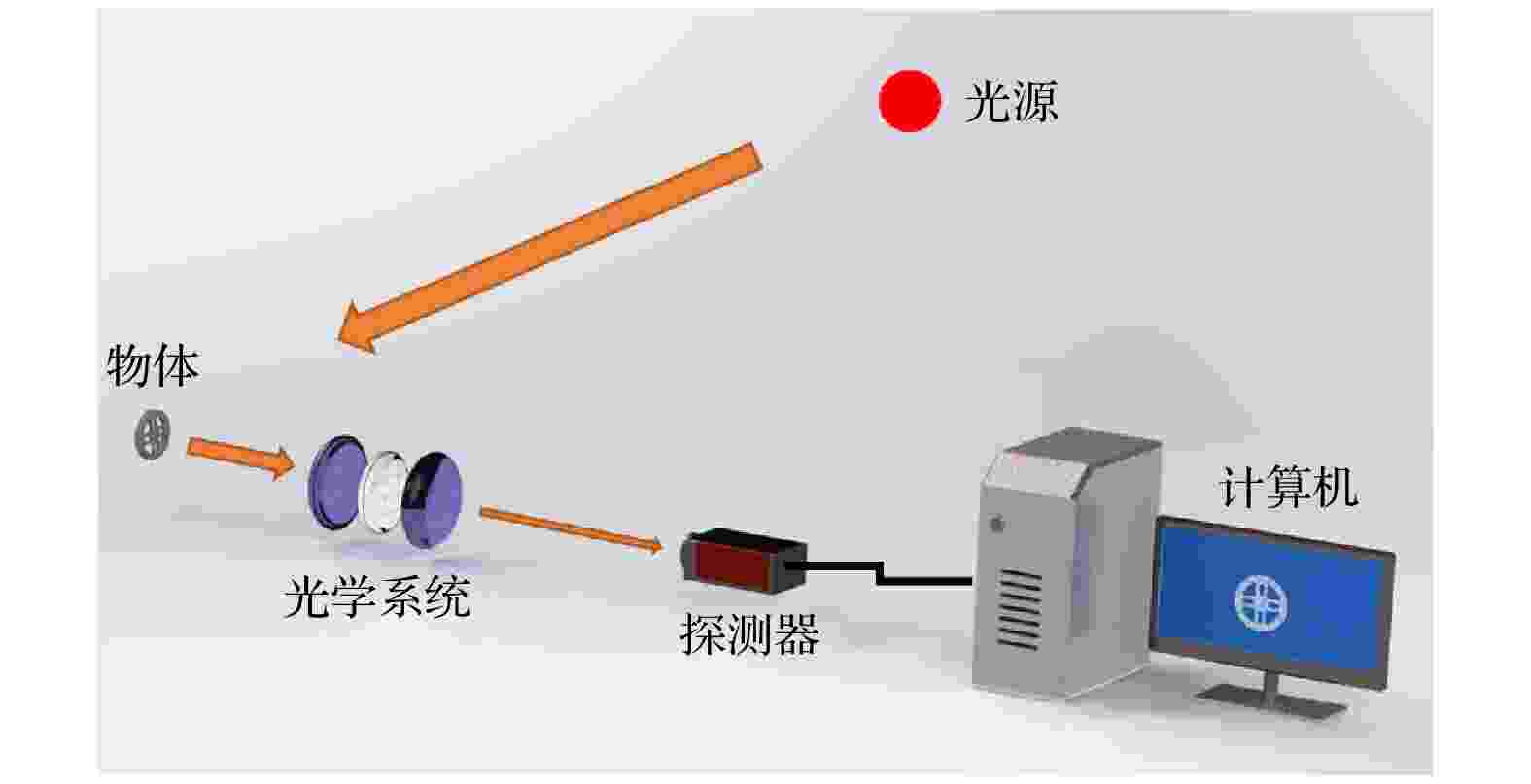
2023, 72 (18): 183301.
doi: 10.7498/aps.72.20231245
Abstract +
Image, as a method of information acquisition, is indispensable for human beings, and it plays an irreplaceable role in military and civilian fields, such as detection and scouting, precision guidance, transportation, and industrial production. In the outdoor environment, the resolution, signal-to-noise ratio, and working distance of optical imaging are limited as result of the influence of background light, stray light, and atmospheric medium. In recent years, with the development of muti-discipline such as optics, physics, information theory, and computer science, the new optical imaging technologies continue to emerge, thus bringing new opportunities for outdoor optical imaging towards long-distance, large field of view and high information flux. As one of the new active imaging technologies, correlation imaging has the potential applications of robustness against turbulence and noise, and the possibility of beating the Rayleigh limit. It can deal with the problems better, such as sharp attenuation of optical power caused by long distances, detection of interference signals from environmental noise, and influence of turbulence. Based on the principle of optical imaging, this paper analyzes the factors affecting optical imaging, in terms of resolution, signal-to-noise ratio, spatial bandwidth product, and imaging distance under outdoor environment, focusing on the research progress of outdoor correlation imaging including imaging systems, signal-to-noise screening technology and imaging algorithm. In addition, we analyze the requirements of optical imaging for longer distances and broader field of view, and consider the fundamental problems and the key technologies.
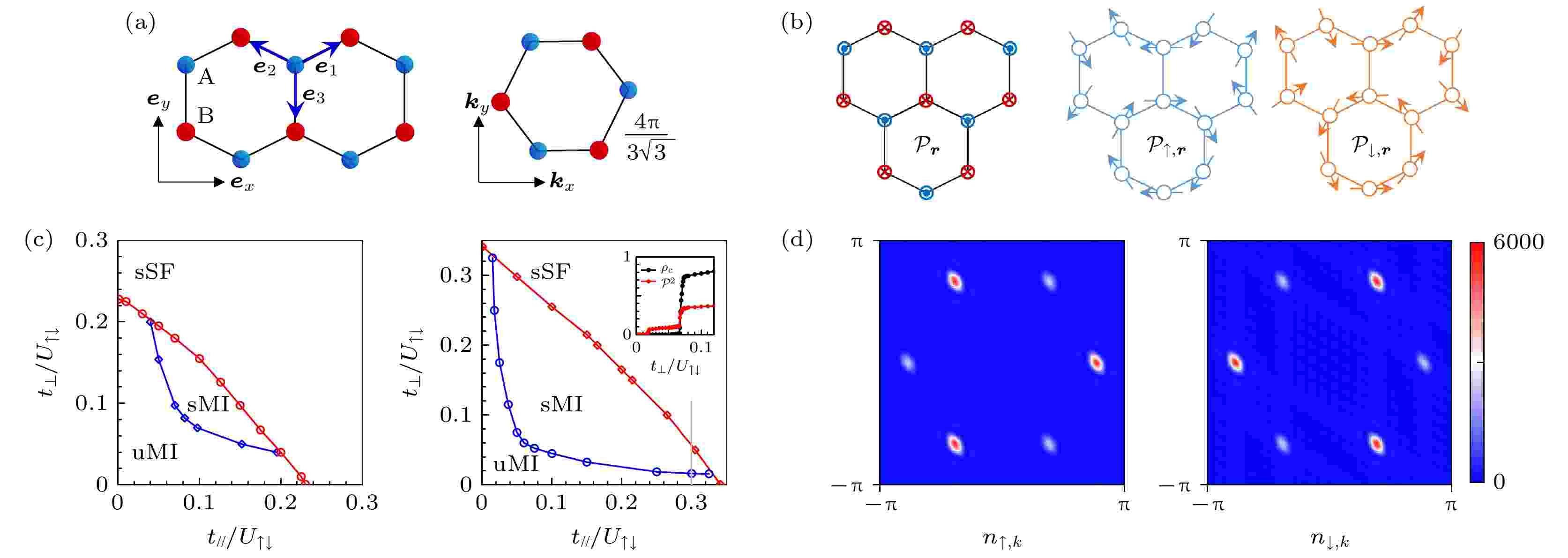
2023, 72 (18): 183701.
doi: 10.7498/aps.72.20230701
Abstract +
With the development of atomic cooling technology and optical lattice technology, the quantum system composed of optical lattice and ultracold atomic gas has become a powerful tool for quantum simulation. The purity and highly controllable nature of the optical lattice give it a strong regulatory capability. Therefore, more complex and interesting physical phenomena can be simulated, which deepens the understanding of quantum many-body physics. In recent years, we have studied different Bose systems with strong correlations in optical lattice based on the bosonic dynamical mean-field theory, including multi-component system, high- orbit bosonic system, and long-range interaction system. In this review, we introduce the research progress of the above mentioned. Through the calculation by using bosonic dynamical mean-field theory which has been generalized to multi-component and real space versions, a variety of physical phenomena of optical crystal lattice Bose system in weak interaction intervals to strong interaction intervals can be simulated. The phase diagram of spin-1 ultracold bosons in a cubic optical lattice at zero temperature and finite temperature are drawn. A spin-singlet condensate phase is found, and it is observed that the superfluid can be heated into a Mott insulator with even (odd) filling through the first (second) phase transition. In the presence of a magnetic field, the ground state degeneracy is broken, and there are very rich quantum phases in the system, such as nematic phase, ferromagnetic phase, spin-singlet insulating phase, polar superfluid, and broken-axisymmetry superfluid. In addition, multistep condensations are also observed. Further, we calculate the zero-temperature phase diagram of the mixed system of spin-1 alkali metal atoms and spin-0 alkali earth metal atoms, and find that the system exhibits a non-zero magnetic ordering, which shows a second-order Mott insulation-superfluid phase transition when the filling number is $n=1$ , and a first-order Mott insulation-superfluid phase transition when the filling number is $n=2$ . The two-step Mott-insulating-superfluid phase transition due to mass imbalance is also observed. In the study of long-range interactions, we first use Rydberg atoms to find two distinctive types of supersolids, and then realize the superradiant phase coupled to different orbits by controlling the reflection of the pump laser in the system coupled to the high-finesse cavity. Finally, we study the high-orbit Bose system. We propose a new mechanism of spin angular-momentum coupling with spinor atomic Bosons based on many-body correlation and spontaneous symmetry breaking in a two-dimensional optical lattice, and then study the orbital frustration in a hexagonal lattice. We find that the interaction between orbital frustration and the strong interaction results in exotic Mott and superfluid phases with spin-orbital intertwined orders.
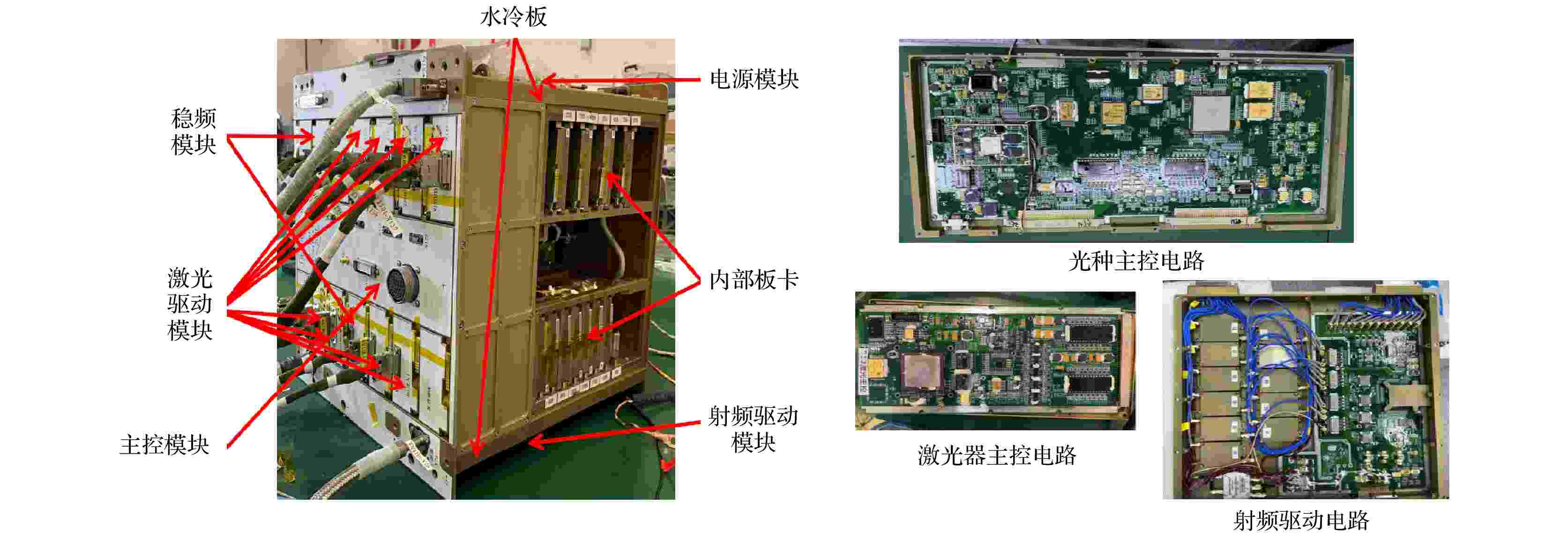
2023, 72 (18): 184202.
doi: 10.7498/aps.72.20230412
Abstract +
The world's first space optical clock (SOC) developed in China, which is composed of five subsystems, i.e. an optical unit, a physics unit, an electronic control unit, a space optical frequency comb, and an ultrastable laser, was successfully launched with the Mengtian space laboratory on October 31, 2022, and entered into the China Space Station (CSS). Compact and stable laser is a key element for the operation of the SOC. The optical unit consists of 5 lasers with wavelengths of 461, 679, 689, 707 and 813 nm, respectively. With a synchronous-tuning-like scheme, high-quality external cavity diode lasers (ECDLs) are developed as the seeds. The linewidths of the lasers are all reduced to approximately 100 kHz, and their tuning ranges, free from mode hopping, are capable of reaching 20 GHz, satisfying the requirements for the SOC. With careful mechanical and thermal design, the stability of the laser against vibration and temperature fluctuation is sufficiently promoted to confront the challenge of rocket launching. While the power from the ECDL is sufficient for 679-nm repump laser and 707-nm repump laser, additional injection lock is utilized for the 461-nm laser and 689-nm laser to amplify the power of the seeds to more than 600 mW, so that effective first and second stage Doppler cooling can be achieved. To generate an optical lattice with deep enough potential well, over 800-mW 813-nm lasers are required. Therefore, a semiconductor tapered amplifier is adopted to amplify the seed to more than 2 W, so as to cope with various losses of the coupling optics. The wavelengths and output power values of the 5 lasers are monitored and feedback is controlled by the electronic control unit. All the modules are designed and prepared as orbital replaceable units, which can be easily replaced by astronauts in case failure occurs. Now the lasers are all turned on and operate normally in CSS. More data of the SOC will be obtained in the near future. At present stage, according to our evaluation, the continuous operation time of the SOC is limited by the injection locked lasers, which are relatively vulnerable to mode hopping. Hopefully, this problem can be solved by improving the laser diode preparing technology, or developing fiber lasers with compact frequency conversion modules.
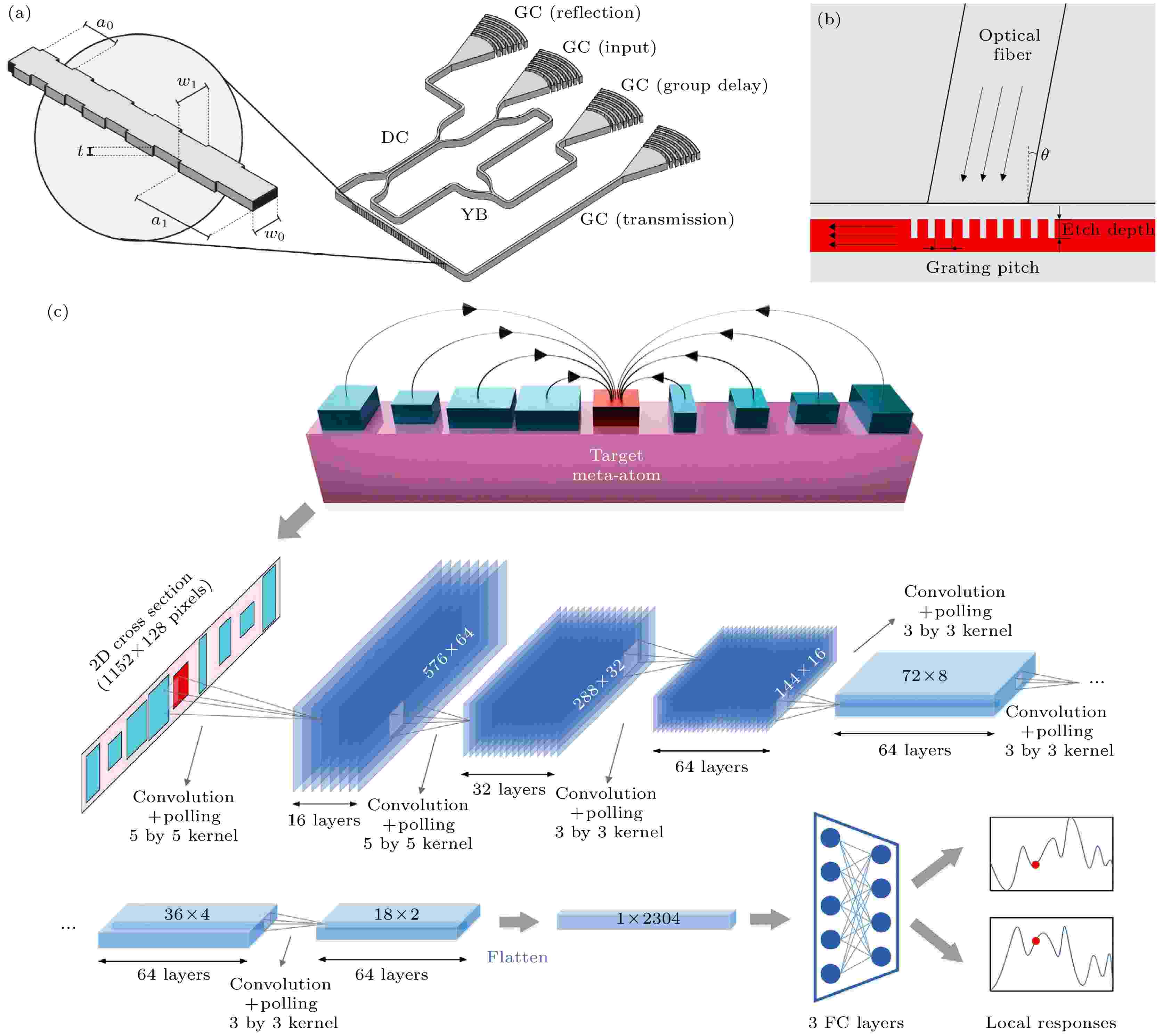
2023, 72 (18): 184204.
doi: 10.7498/aps.72.20230705
Abstract +
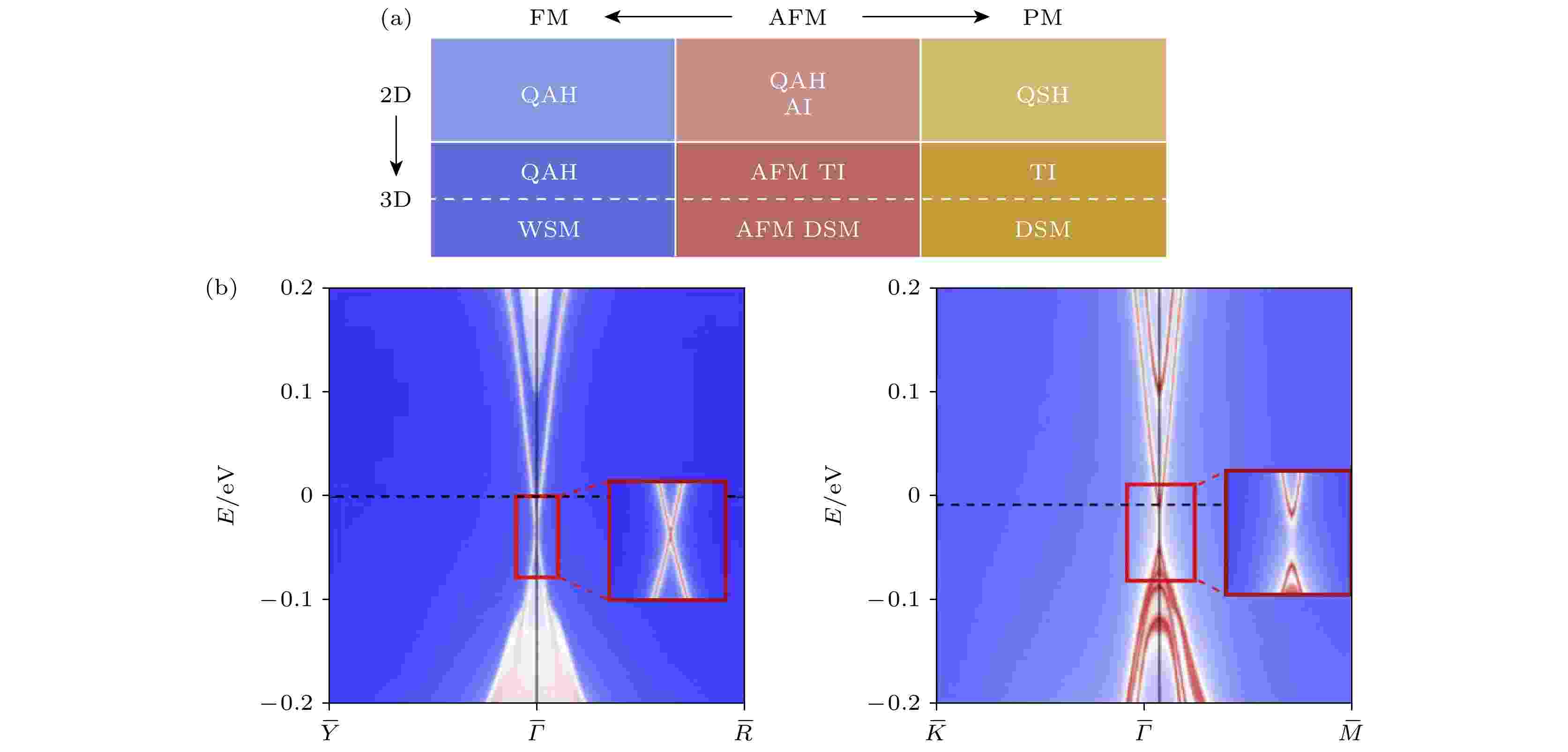
2023, 72 (18): 187101.
doi: 10.7498/aps.72.20230704
Abstract +
The interaction between non-trivial topological states and the magnetic order of intrinsic magnetic topological insulators gives rise to various exotic physical properties, including the quantum anomalous Hall effect and axion insulator. These materials possess great potential applications in low-power topological spintronic devices and topological quantum computation. Since the first intrinsic magnetic topological insulator, MnBi2Te4, was discovered in 2019, this material system has received significant attention from researchers and sparked a research boom. This paper begins with discussing the fundamental properties of MnBi2Te4 and then turns to important research findings related to this intrinsic magnetic topological insulator. Specifically, it focuses on the quantum anomalous Hall effect, axion insulating state, and Majorana zero energy mode exhibited by the MnBi2Te4 series. Furthermore, this paper highlights other research directions and current challenges associated with this material system. Finally, this paper provides a summary and outlook for future research on MnBi2Te4, aiming to offer valuable references for researchers in related fields.
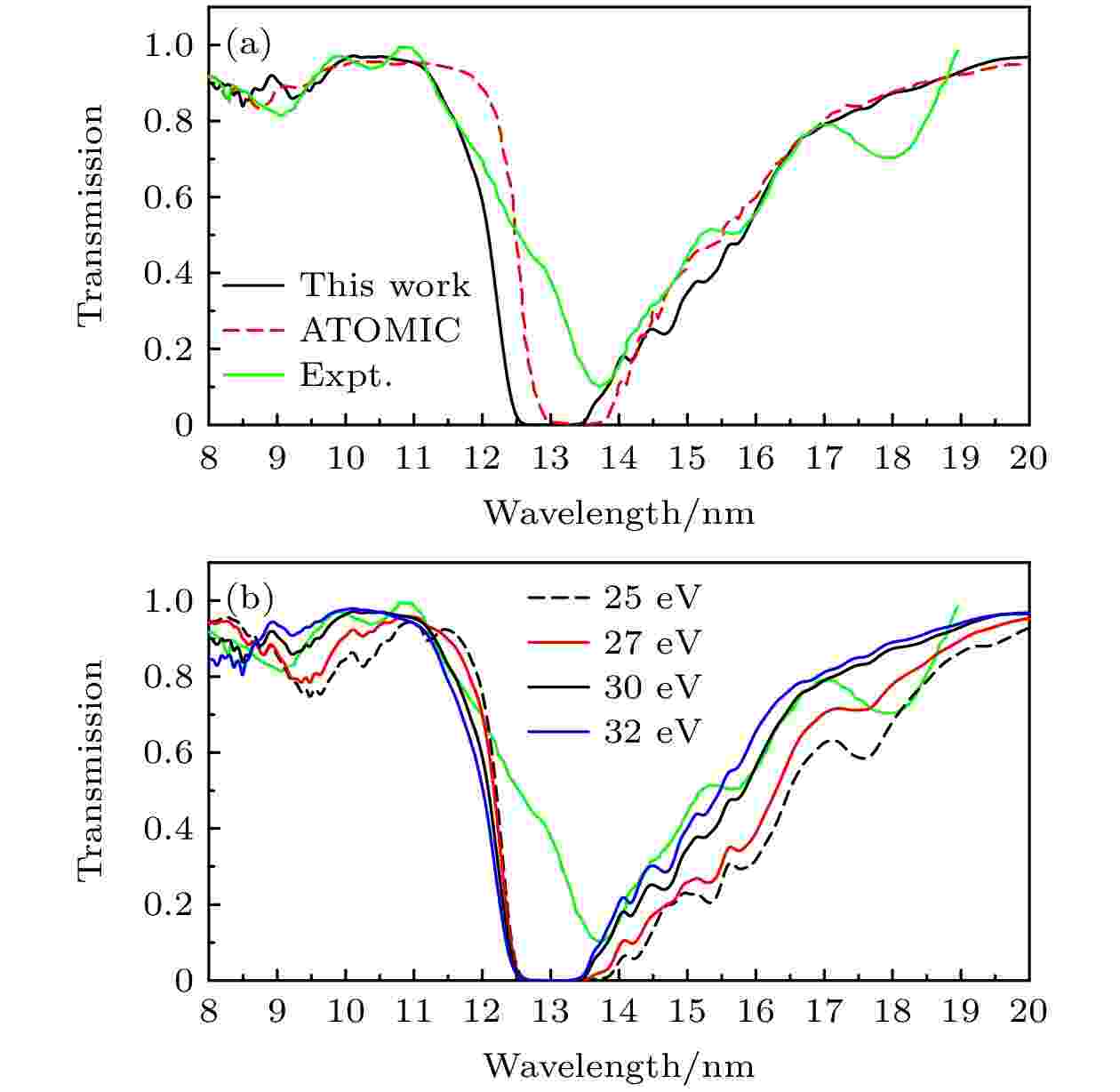
2023, 72 (18): 183101.
doi: 10.7498/aps.72.20230455
Abstract +
Sn is the material for an extreme ultraviolet (EUV) light source working at 13.5 nm, therefore the radiative properties of Sn plasma are of great importance in designing light source. The radiative opacity and emissivity of Sn plasma at local thermodynamic equilibrium are investigated by using a detailed-level-accounting model. In order to obtain precise atomic data, a multi-configuration Dirac-Fock method is used to calculate energy levels and oscillator strengths of ${\rm{Sn}}^{6+}$ -${\rm{Sn}}^{14+}$ . The electronic correlation effects of $4{\rm d}^m\text{-}4{\rm f}^m$ ($m=1, 2, 3, 4$ ) and $ 4\mathrm{p}^n\text{-}4\mathrm{d}^n $ ($n=1, 2, 3$ ) are mainly considered, which dominate the radiation near 13.5 nm. The number of fine-structure levels reaches about 200000 for each ionization stage in the present large-scale configuration interaction calculations. For the large oscillator strengths (> 0.01), the length form is in accord with the velocity form and their relative difference is about 20%–30%. The calculated transmission spectra of Sn plasma at 30 eV and 0.01 g/cm3 are compared with the experimental result, respectively, showing that they have both good consistency. The radiative opacity and emissivity of Sn plasma at the temperature in a range of 16–30 eV and density in a scope of of 0.0001–0.1 g/cm3 are investigated systematically. The effects of the plasma temperature and plasma density on radiation characteristics are studied. The results show that the radiative properties near 13.5 nm are broadened with the increase of density at a specific temperature, while it is narrowed with the increase of temperature for a specific density. The present investigation should be helpful in designing and studying EUV light source in the future.
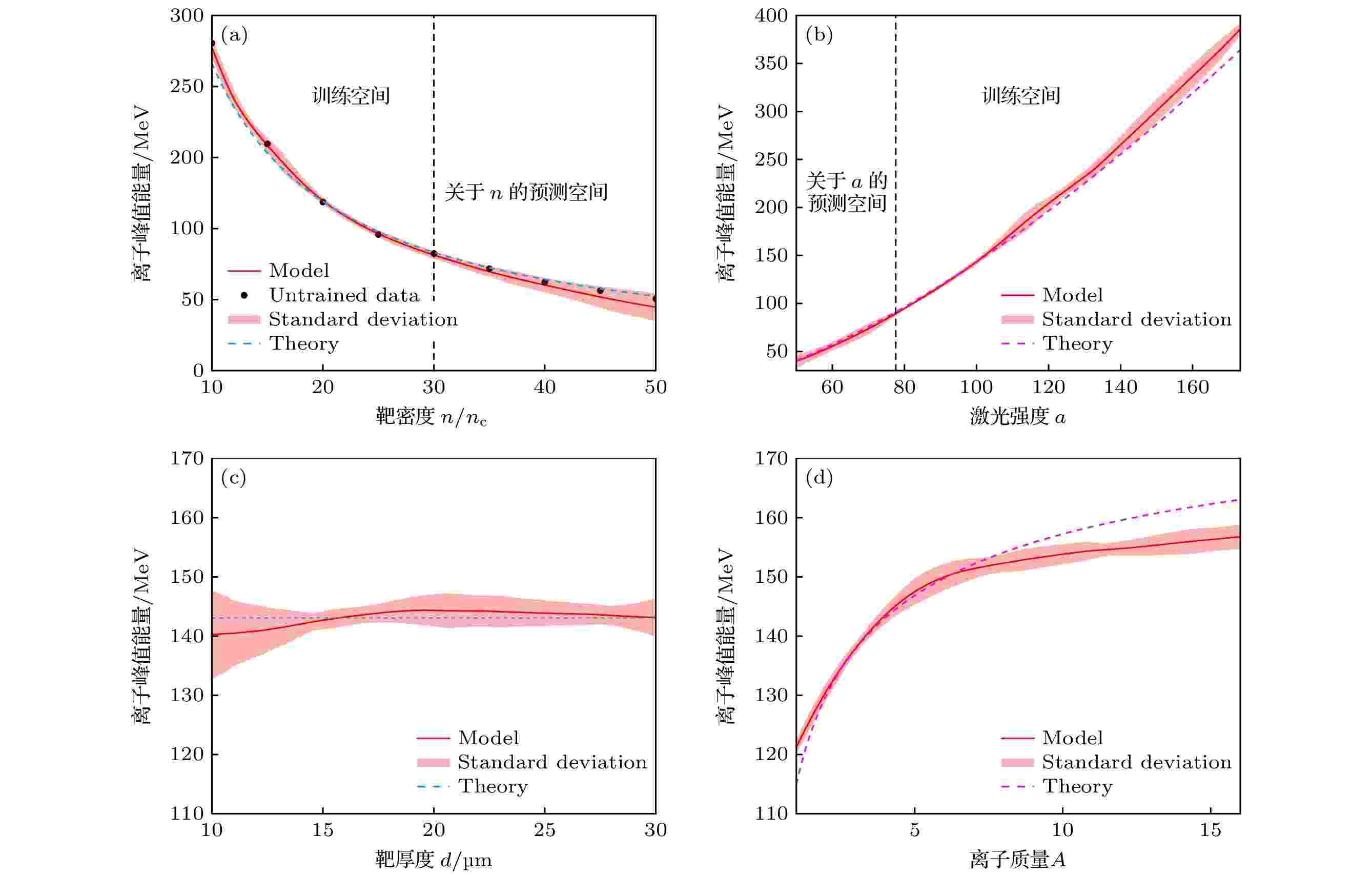
2023, 72 (18): 184103.
doi: 10.7498/aps.72.20230702
Abstract +
Laser-driven ion acceleration has potential applications in high energy density matter, ion beam-driven fast ignition, beam target neutron source, warm dense matter heating, etc. Ultrashort relativistic laser interacting with solid target can generate ion beam with several hundreds of MeV in energy, and the quality of the ion beam depends strongly on the interaction parameters between the laser and the target. Development in deep learning can provide new method of analyzing the relationship between parameters in physics system, which can significantly reduce the computational and experimental cost. In this paper, a continuous mapping model of ion peak and cutoff energy is developed based on a fully connected neural network (FCNN). In the model, the dataset is composed of nearly 400 sets of particle simulations of laser-driven solid targets, and the input parameters are laser intensity, target density, target thickness, and ion mass. The model uses sparse parameter values to obtain the analysis results in a large range of parameters, which greatly reduces the computational amount of multi-dimensional parameters sweeping in a wide range. Based on the results of this model mapping, the correction formula for the ion peak energy is obtained. Furthermore, the ratio of ion cutoff energy to peak energy of each set of particle simulation is calculated. Repeating the same training process of ion peak energy and cutoff energy, the continuous mapping model of energy ratio is developed. According to the energy ratio model mapping results, the quantitative description of the relationship between ion cutoff energy and peak energy is realized, and the fitting formula for the cutoff energy of the hole-boring radiation pressure acceleration (HB-RPA) mechanism is obtained, which can provide an important reference for designing the laser-driven ion acceleration experiments.
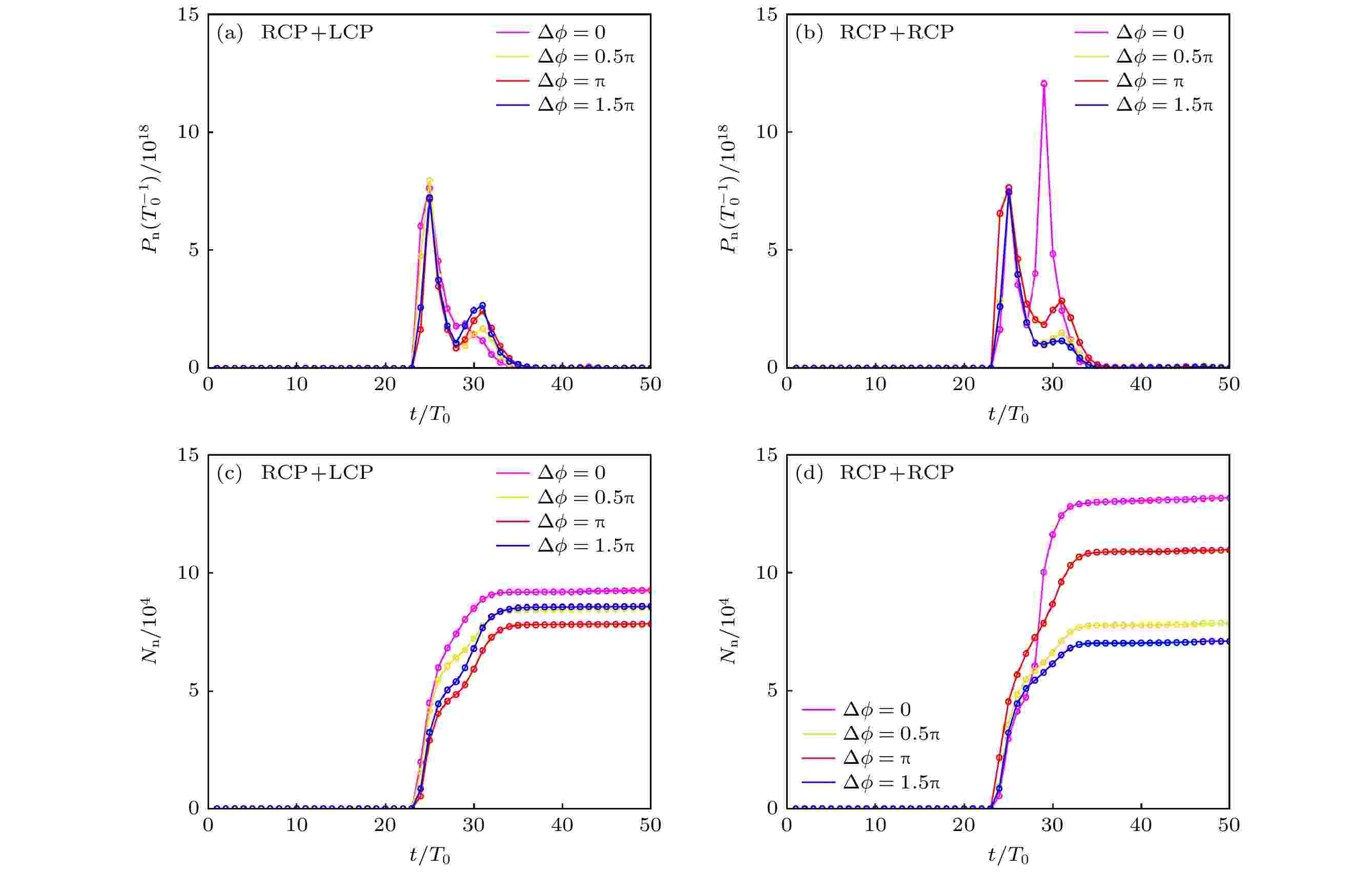
2023, 72 (18): 185201.
doi: 10.7498/aps.72.20230706
Abstract +
Neutron production via D(d, n)3He nuclear reaction during the interaction of two counter-propagating circularly polarized laser pulses with ultra-thin deuterium target is investigated by particle-in-cell simulation and Monte Carlo method. It is found that the rotation direction and initial relative phase difference of laser electric field vector have important effects on deuterium foil compression and neutron characteristics. The reason is attributed to the net light pressure and the difference in transverse instability development. The highest neutron yield can be obtained by choosing two laser pulses with a relative phase difference of 0 and the same rotation direction of the electric field vector. When the relative phase difference is 0.5π or 1.5π and the rotation direction of electric field vector is different, the neutrons have a directional spatial distribution and the neutron yield only slightly decreases. For left-handed circularly polarized laser pulse and right-handed circularly polarized laser pulse, each with an intensity of 1.23 × 1021 W/cm2, a pulse width of 33 fs and a relative phase difference of 0.5π, it is possible to produce a pulsed neutron source with a yield of 8.5 × 104 n, production rate of 1.2 × 1019 n/s, pulse width of 23 fs and good forward direction as well as tunable spatial distribution. Comparing with photonuclear neutron source and beam target neutron source driven by ultraintense laser pulses, the duration of neutron source in our scheme decreases significantly, thereby possessing many potential applications such as neutron nuclear data measurement. Our scheme offers a possible method to obtain a compact neutron source with short pulse width, high production rate and good forward direction.
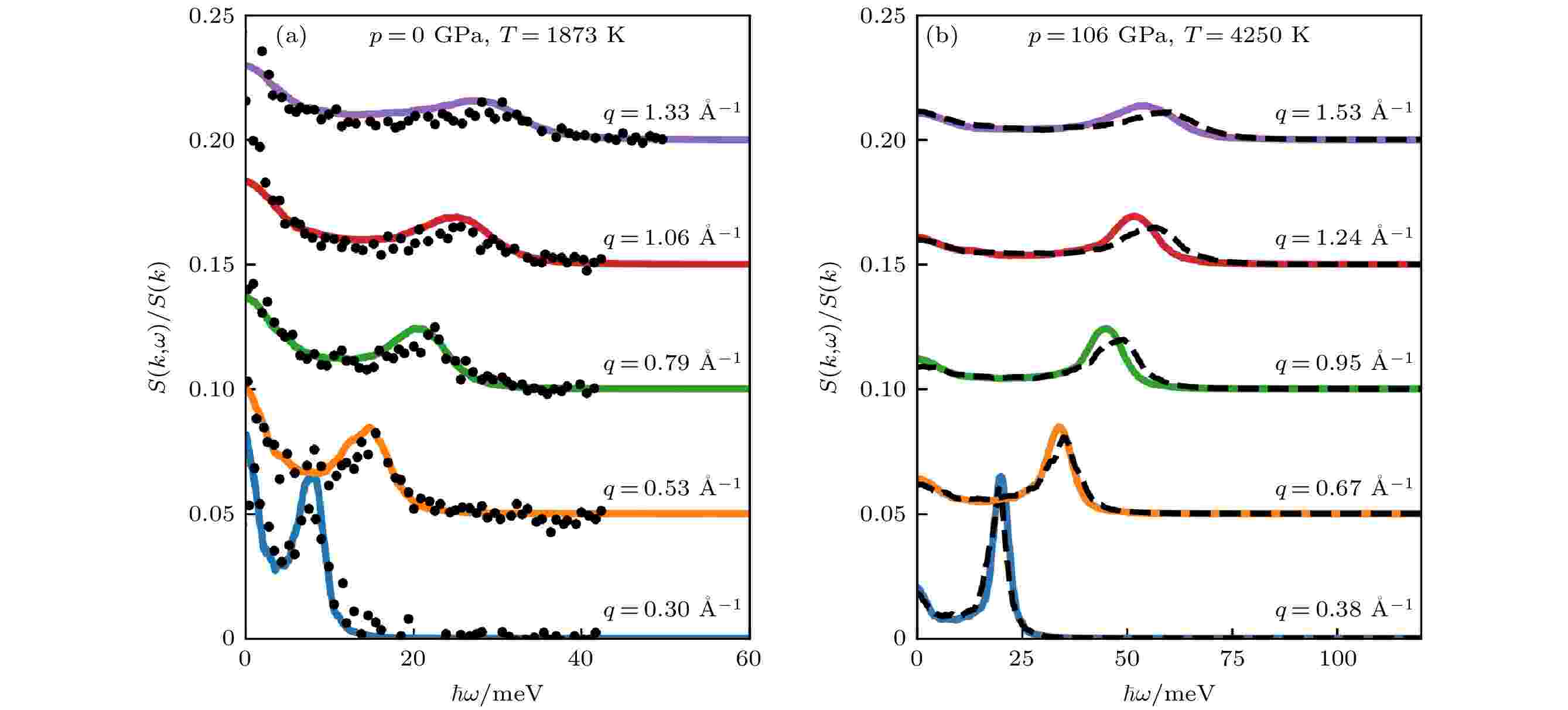
2023, 72 (18): 187102.
doi: 10.7498/aps.72.20231258
Abstract +
Liquid iron is the major component of planetary cores. Its structure and dynamics under high pressure and temperature is of great significance in studying geophysics and planetary science. However, for experimental techniques, it is still difficult to generate and probe such a state of matter under extreme conditions, while for theoretical method like molecular dynamics simulation, the reliable estimation of dynamic properties requires both large simulation size and ab initio accuracy, resulting in unaffordable computational costs for traditional method. Owing to the technical limitation, the understanding of such matters remains limited. In this work, combining molecular dynamics simulation, we establish a neural network potential energy surface model to study the static and dynamic properties of liquid iron at its extreme thermodynamic state close to core-mantle boundary. The implementation of deep neural network extends the simulation scales from one hundred atoms to millions of atoms within quantum accuracy. The estimated static and dynamic structure factor show good consistency with all available X-ray diffraction and inelastic X-ray scattering experimental observations, while the empirical potential based on embedding-atom-method fails to give a unified description of liquid iron across a wide range of thermodynamic conditions. We also demonstrate that the transport property like diffusion coefficient exhibits a strong size effect, which requires more than at least ten thousands of atoms to give a converged value. Our results show that the combination of deep learning technology and molecular modelling provides a way to describe matter realistically under extreme conditions.

2023, 72 (18): 187901.
doi: 10.7498/aps.72.20230699
Abstract +
We study experimentally the three-body Coulomb explosion dynamics of carbon dioxide dimer ${\rm{(CO_2)}}_{2}^{4+}$ ions produced by intense femtosecond laser field. The three-dimensional momentum vectors as well as kinetic energy are measured for the correlated fragmental ions in a cold-target recoil-ion momentum spectrometer (COLTRIMS). Carbon dioxide dimer is produced during the supersonic expansion of ${\rm{(CO_2)_2}}$ gas from a 30 μm nozzle with 10 bar backing pressure. The linearly polarized laser pulses with a pulse duration (full width at half maximum of the peak intensity) of 25 fs, a central wavelength of 790 nm, a repetition rate of 10 kHz, and peak laser intensities on the order of ${\rm{8 \times10^{14}}}\;{\rm{W/cm^2}}$ are produced by a femtosecond Ti:sapphire multipass amplification system. We concentrate on the three-particle breakup channel ${\rm{(CO_2)_2^{4+}}} \rightarrow {\rm{CO}}_{2}^{2+}+{\rm{CO^+}}+ {\rm{O^+}}$ . The two-particle breakup channels, ${\rm{(CO_2)_2^{4+}}} \rightarrow {\rm{CO}}_{2}^{2+}+ {\rm{CO_{2}}^{2+}}$ and ${\rm{CO_2^{2+}}\rightarrow CO^++O^+}$ , are selected as well for reference. The fragmental ions are guided by a homogenous electric field of 60 V/cm toward microchannel plates position-sensitive detector. The time of flight (TOF) and position of the fragmental ions are recorded to reconstruct their three-dimensional momenta. By designing some constraints to filter the experimental data, we select the data from different dissociative channels. The results demonstrate that the three-body Coulomb explosion of ${\rm{(CO_2)}}_{2}^{4+}$ ions break into ${\rm{CO}}_{2}^{2+}+{\rm{CO}}^++{\rm{O}}^+$ through two mechanisms: sequential fragmentation and non-sequential fragmentation, in which the sequential fragmentation channel is dominant. These three fragmental ions are produced almost instantaneously in a single dynamic process for the non-sequential fragmentation channel but stepwise for the sequential fragmentation. In the first step, the weak van der Waals bond breaks, ${\rm{(CO_2)}}_{2}^{4+}$ dissociates into two ${\rm{CO}}_{2}^{2+}$ ions; and then one of the C=O covalent bonds of ${\rm{CO}}_{2}^{2+}$ breaks up, the ${\rm{CO}}_{2}^{2+}$ ion breaks into ${\rm{CO^+}}$ and ${\rm{O^+}}$ . The time interval between the two steps is longer than the rotational period of the intermediate ${\rm{CO}}_{2}^{2+}$ ions, which is demonstrated by the circle structure exhibited in the Newton diagram. We find that the sequential fragmentation channel plays a dominant role in the three-body Coulomb explosion of ${\rm{(CO_2)}}_{2}^{4+}$ ions in comparison of the event ratio of the two fragmentation channels.
SPECIAL TOPIC—Nonlinear system theory and its frontier applications
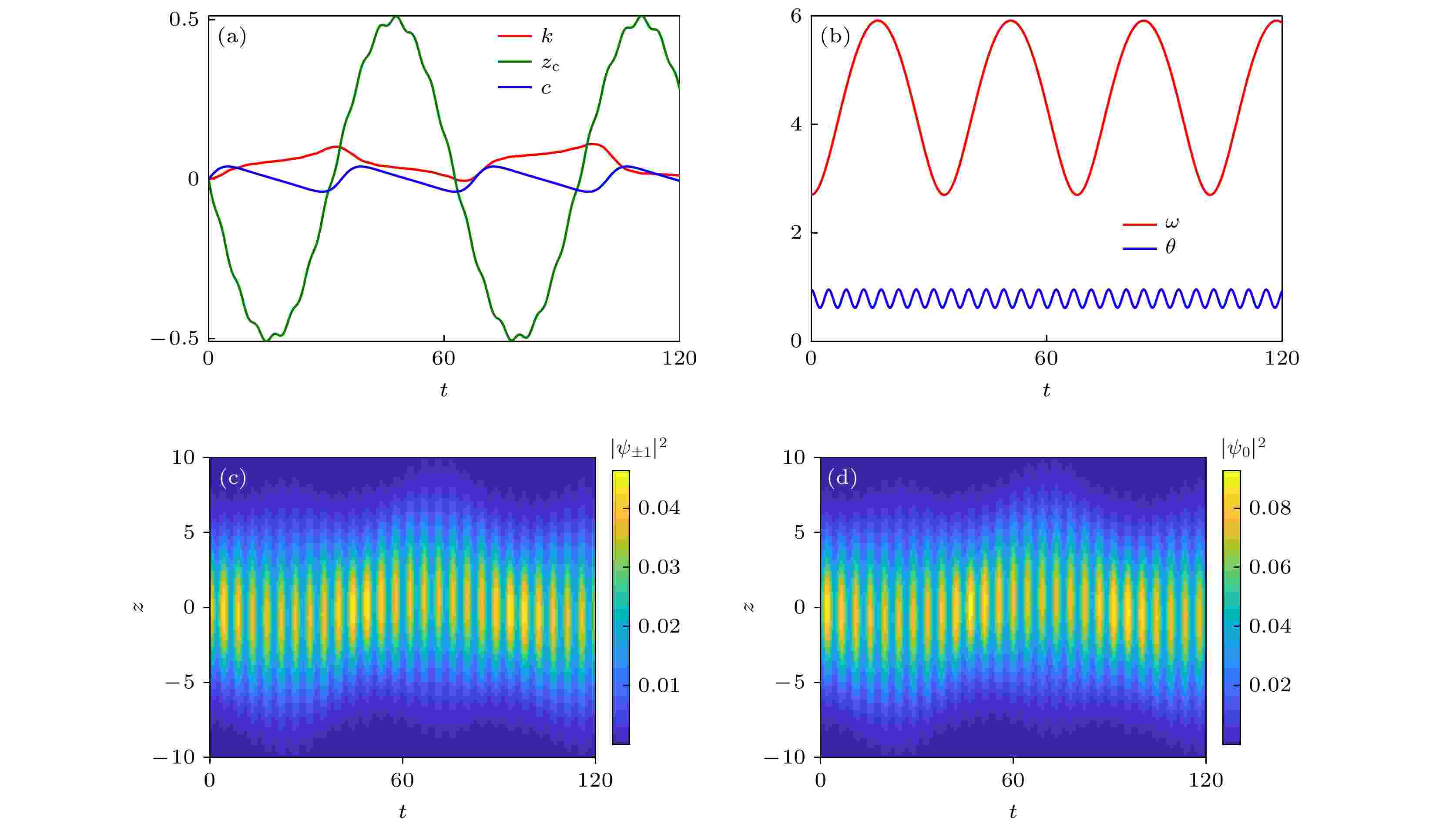
2023, 72 (18): 180304.
doi: 10.7498/aps.72.20231076
Abstract +
We investigate the dynamics of the plane wave state in one-dimensional spin-tensor-momentum coupled Bose-Einstein condensate. By using the Gaussian variational approximation, we first derive the equations of motion for the variational parameters, including the center-of-mass coordinate, momentum, amplitude, width, chirp, and relative phase. These variational parameters are coupled together nonlinearly by the spin-tensor-momentum coupling, Raman coupling, and the spin-dependent atomic interaction. By minimizing the energy with respect to the variational parameters, we find that the ground state is a biaxial nematic state, the momentum of the ground state decreases monotonically with the increase of the strength of the Raman coupling, and the parity of real part of the ground-state wave function is opposite to that of the imaginary part. The linear stability analysis shows that the ground state is dynamically stable under a perturbation, and exhibits three different oscillation excitation modes, the frequencies of which are related to the strength of the Raman coupling, the aspect ratio of the harmonic trap, and the strength of the atomic interaction. By solving the equations of motion for the variational parameters, we find that the system displays periodical oscillation in the dynamical evolution. These variational results are also confirmed by the direct numerical simulations of the Gross-Pitaevskii equations, and these findings reveal the unique properties given by the spin-tensor-momentum coupling.
REVIEW

EDITOR'S SUGGESTION
2023, 72 (18): 184401.
doi: 10.7498/aps.72.20230687
Abstract +
The graded thermal conductivity in nanoscale “hot spot” system is a new phenomenon in nanoscale heat conduction. It is found that the thermal conductivity is no longer uniform, and the thermal conductivity gradually increases from the inside to the outside in the radial direction, which no longer obeys Fourier’s law of thermal conductivity. An in-depth understanding of the mechanism of the graded thermal conductivity can provide a theoretical basis for solving engineering problems such as heat dissipation of nanochip. This paper first reviews the new phenomenon of heat conduction recently discovered in nanosystem, then, focuses on the graded thermal conductivity in the “hot spot” system, and expounds the variation law of the graded thermal conductivity in different dimensional systems. According to the changes of atomic vibration mode and phonon scattering, the physical mechanism of the graded thermal conductivity is explained. Finally, the new challenges and opportunities brought by the graded thermal conductivity characteristics of nano “hot spot” to the heat dissipation of nanodevices are summarized, and the future research in this direction is also prospected.
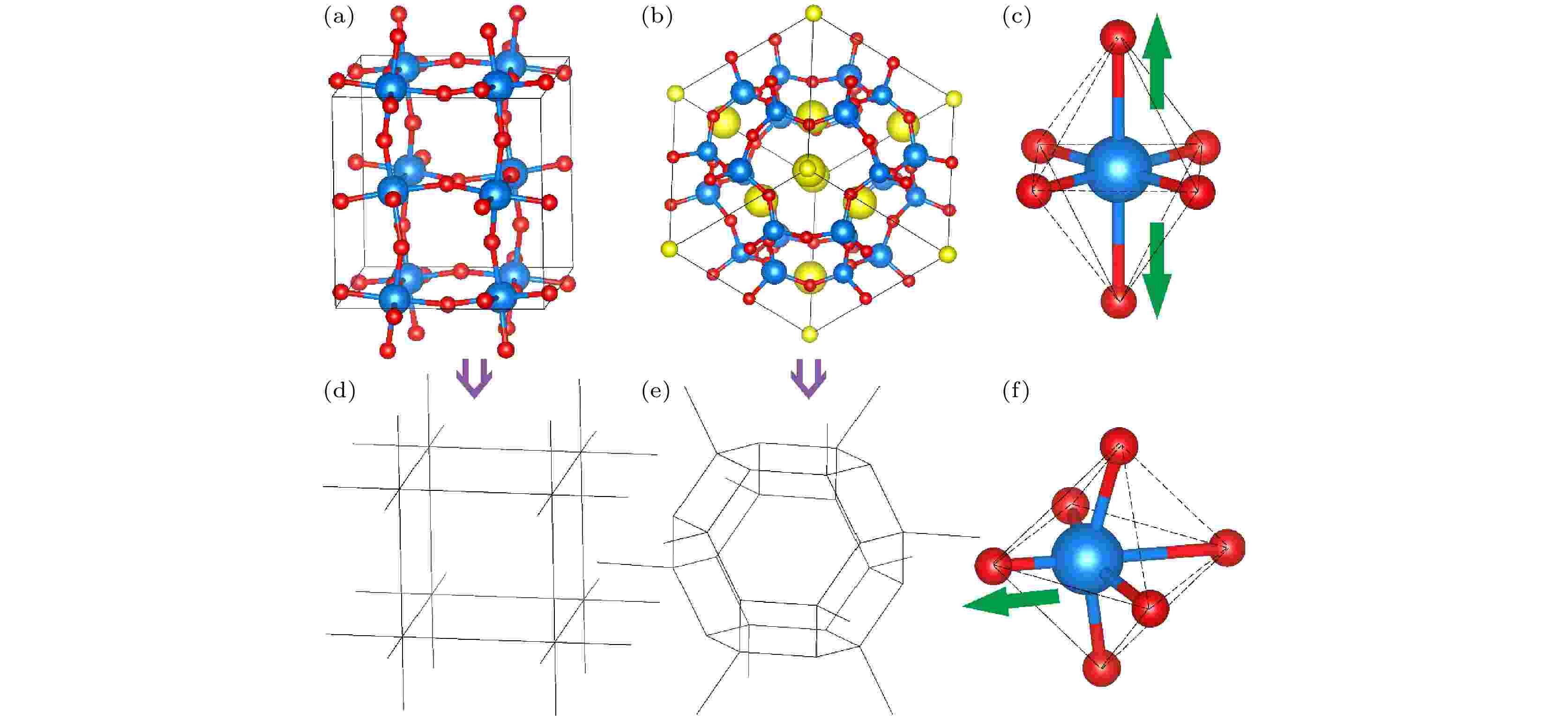
EDITOR'S SUGGESTION
2023, 72 (18): 186101.
doi: 10.7498/aps.72.20230947
Abstract +
Corner-shared coordination polyhedral crystals (CSCPCs) represented by perovskites have unique and various properties in optics, electrics, and magnetism, leading to their broad applications such as in serving as ferroelectric material, fast ionic conductors, and electro/photo-catalysts. However, the excellent properties are owned only by a very small fraction of CSCPS phases. How to obtain such phases through structural operation has always been a research hotspot and a bottleneck in related fields. Herein, we review the recent research progress of the synthesis of high-performance CSCPC materials from the perspective of phase structure, in order to clarify the intrinsic rules of phase evolution and reveal the mechanism behind the phase manipulation. We first systematically summarize the types of polyhedra and crystal frameworks in CSCPCs and classify the polyhedral distortions as three main types, i.e. cation displacements, polyhedral rotations, and deformations. Based on that, we further analyze and conclude different material synthesis methods. We find that most traditional synthesis methods rely on the phase transitions induced by the change of external physical conditions at a macroscopic level, such as composition, temperature, and pressure. Recently, there was an emerging synthesis method focusing on the microscopic manipulation of polyhedral geometry and topology, such as phase constructions according to tolerance-factor and substrate-proximity effects. The macroscopic synthesis methods and the microscopic synthesis methods share the same phase manipulation mechanism: making crystals transit into the structure-specified phases by inducing polyhedral distortions. The only difference is that the latter is more target-oriented, but its applications are currently limited to octahedral coordination tilt/rotation systems. Expanding its application scope is still a challenge. In addition, we propose two aspects that may be useful in optimizing the synthesis method: one is to clarify the origin of induced distortions and the interaction between different distortions, and the other is to customize the guidelines based on computer science. We hope that the research progress reviewed in this article can provide some valuable references and inspirations for designing and synthesizing the high-performance CSCPC materials.
GENERAL

EDITOR'S SUGGESTION
2023, 72 (18): 180201.
doi: 10.7498/aps.72.20230418
Abstract +
Existing uniform fields are usually based on the special arrangement of the array antenna. The uniform fields generated by flat-top beam shaping in angular far-field area or by point focusing in near-field area are directly subject to the array configuration and cannot be flexibly controlled. This paper presents a method of generating uniform field based on the combination of angular spectral domain and improved time reversal technique. This method is not limited by the array arrangement. It can generate a uniform field of specified size, shape and deflection angle in the same array arrangement at any position, including the near-field region. In this work, the reason why this method is not limited by array arrangement is explained theoretically. Secondly, the ability of the fixed array configuration to generate multiple uniform fields is validated numerically. Finally, the time-reversal technique of reversal signal amplitude reciprocal weighting is introduced. The problem of deterioration of uniform field flatness, caused by amplitude decay and phase delay during the generation of uniform field, is solved through this technology. The results show that the quality of the synthesized field is related to the main lobe and sidelobe information of its corresponding angular spectrum domain envelope, and the generated any uniform field must contain at least half of the angular spectrum domain main lobe information and half of the sidelobe information. This method can flexibly control the position, size, shape and deflection angle of one-dimensional and two-dimensional uniform field, which provides a new way to flexibly generating uniform fields.

2023, 72 (18): 180202.
doi: 10.7498/aps.72.20230382
Abstract +
The search for ferromagnetic materials with high Curie temperature (Tc) is a hot issue in condensed matter physics. In this work, an effective machine learning model of Curie temperature based on material component information is established to predict a variety of ferromagnetic materials with high Curie temperature. Based on the collected data of 1568 ferromagnetic materials, and taking the component information of ferromagnetic materials as descriptors, in this work four efficient machine learning models are constructed, namely support vector regression, kernel ridge regression, random forest and extremely randomized trees, through hyperparameter optimization and ten-break cross-validation. Of them, extremely randomized tree model has the best prediction performance, and its cross-validation R2 score can reach 81.48%. At the same time, the extremely randomized tree model is also used to predict 36949 materials in the materials project database, and 338 ferromagnetic materials with Tc greater than 600 K are found in this work. The method proposed in this paper can help obtain ferromagnetic materials with high Curie temperature and accelerate the process of ferromagnetic material design.
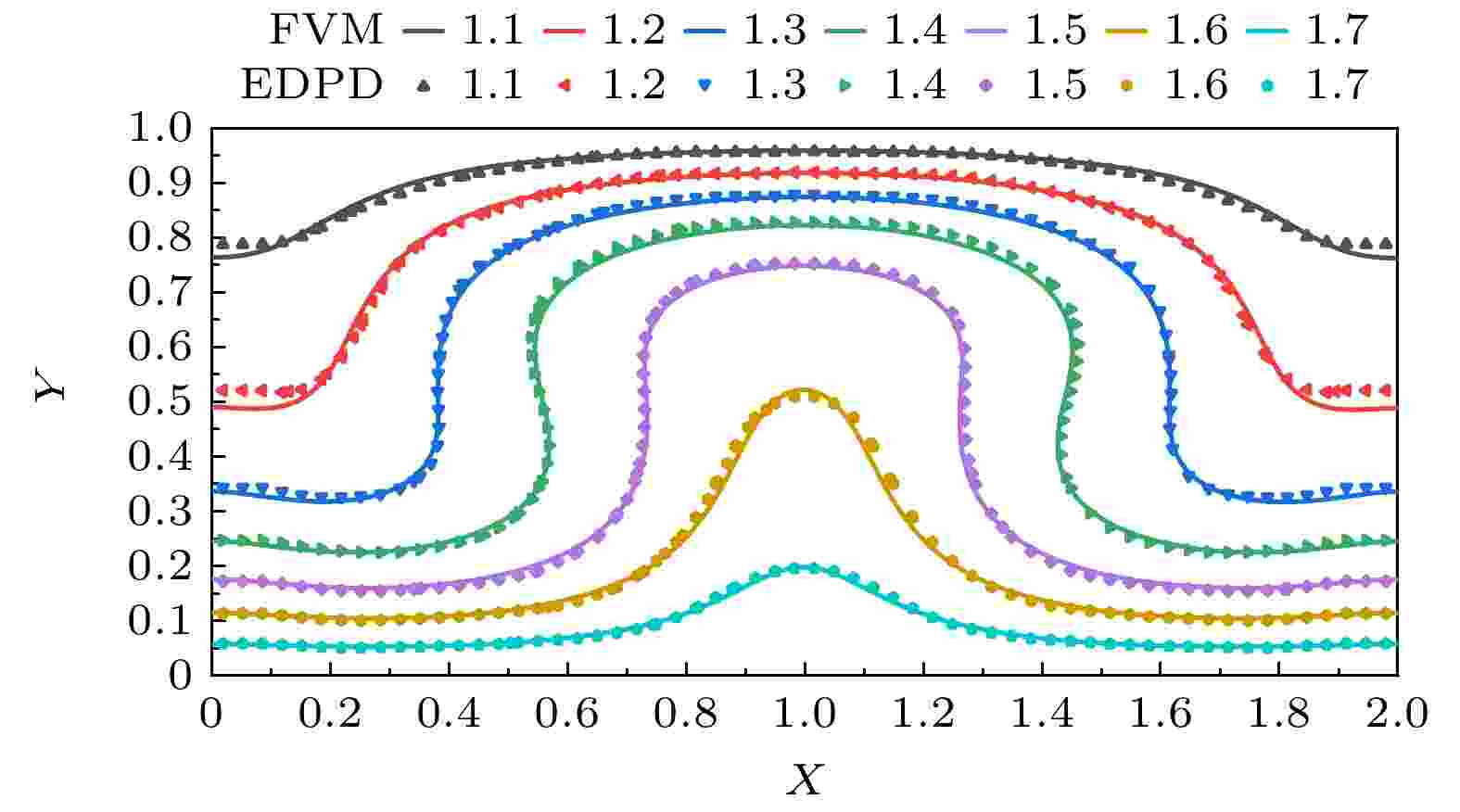
2023, 72 (18): 180203.
doi: 10.7498/aps.72.20230495
Abstract +
Energy conservation dissipative particle dynamics (eDPD) is a mesoscale numerical simulation method of studying the heat transport process. In previous studies, when the Boussinesq assumption was introduced into the eDPD system to study the natural convection, the system was generally considered to be incompressible, and the effect of the thermal expansion of the eDPD system itself on the simulation results was often neglected, which would cause errors in the simulation. In the present study, the thermal expansion characteristic of the eDPD system is first investigated, and the thermal expansion coefficient β of the eDPD system is obtained by eDPD simulation. Then, based on the thermal expansion characteristic of the eDPD system itself, the natural convection is simulated with different values of Rayleigh number Ra and different geometries, specifically, square cavity, concentric rings, and eccentric rings, and reasonable temperature and velocity fields are obtained, and they are in agreement with the simulated results by the finite volume method (FVM). The error between the eDPD simulation, in which the natural convection is driven by thermal expansion of the eDPD system itself, and FVM simulated result is considerably smaller than the errors observed in previous studies where Boussinesq assumption was directly adopted to simulate natural convection phenomena while neglecting the thermal expansion effect of eDPD system. It is shown that the effect of the eDPD system’s own thermal expansion characteristic needs to be considered when introducing the Boussinesq assumption in the eDPD system, and further, the calculation of the Ra number is modified in this paper.
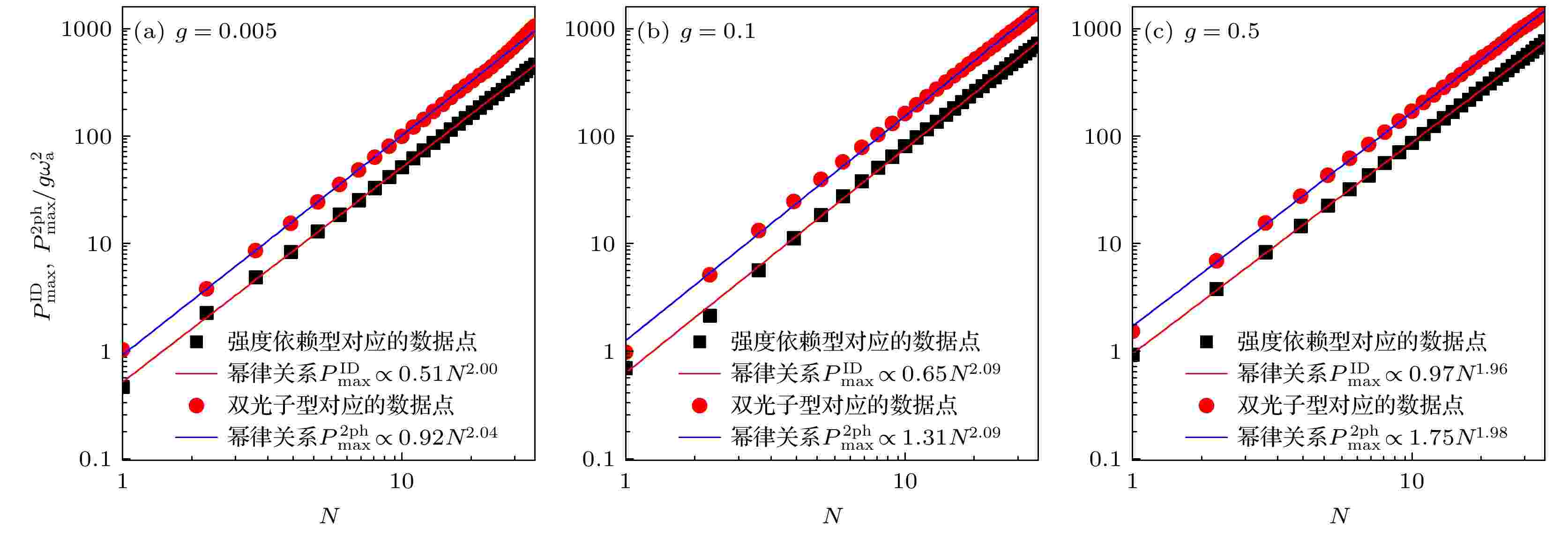
2023, 72 (18): 180301.
doi: 10.7498/aps.72.20230578
Abstract +
Recently, quantum battery based on various physical models from quantum optics model to spin model and its enhancement of charging performance have attracted increasing interest. It has been demonstrated that quantum entanglement is beneficial to the speedup of work extraction. In this paper, by an exact diagonalization approach, we investigate the charging performance of the field intensity-dependent Dicke model (also called intensity-dependent Dicke model) quantum battery, which consists of N qubits collectively interacting with a single-mode cavity. The considered intensity-dependent Dicke model is a generalized Dicke model with a nonlinear-coupling fashion and different weights of energy conserved term and non-conserved term. Firstly, we consider the influences of energy non-conserved term (also called anti-rotating wave term) on the maximum stored energy and maximum charging power in quantum battery. It is shown that the maximum stored energy is not very sensitive to the increase of the weight of energy non-conserved term, but the maximum charging power undergoes a significant change with the increase of the weight of energy non-conserved term. We also show that the maximum charging power increases monotonically with the increase of coupling constant between qubits and cavity, but the maximum stored energy is not monotonically related to the increase of coupling constant. Then, we further examine in detail the characteristics of the maximum stored energy, charging time, energy quantum fluctuation and maximum charging power in the quantum battery under the same weight between energy conserved term and non-conserved term. By comparing the charging performances of quantum battery based on the single-photon-Dicke model with those based on the two-photon-Dicke model, we find that the performances, specifically, the charging time and maximum charging power of the intensity-dependent Dicke quantum battery are better than those of single-photon Dicke quantum battery, but weaker than those of two-photon Dicke quantum battery. Of particular interest is that the relationship of maximum charging power with large quantum cell number in intensity-dependent Dicke quantum battery has the same form as that in the two-photon Dicke quantum battery, i.e. their maximum values of charging power are both proportional to the large quantum cell number squared, specifically, $ P_{\mathrm{max}}^{\mathrm{ID}}\propto N^2 $ and $ P\mathrm{_{max}^{2ph}}\propto N^2 $ , which are consistent with the upper bound given by the paper (Gyhm J, Šafránek D, Rosa D 2022 Phys. Rev. Lett. 128 140501 ). It is worthwhile to mention that Dou et al. (Dou F Q, Zhou H, Sun J A 2022 Phys. Rev. A 106 032212 ) showed that using the quantum advantage of maximum charging power in the quantum battery based on cavity Heisenberg-spin-chain model $ P\mathrm{_{max}}\propto N^2 $ can be obtained. Therefore, this study of the charging performance based on the intensity-dependent Dicke quantum battery may provide an alternative approach to the further research on quantum battery.
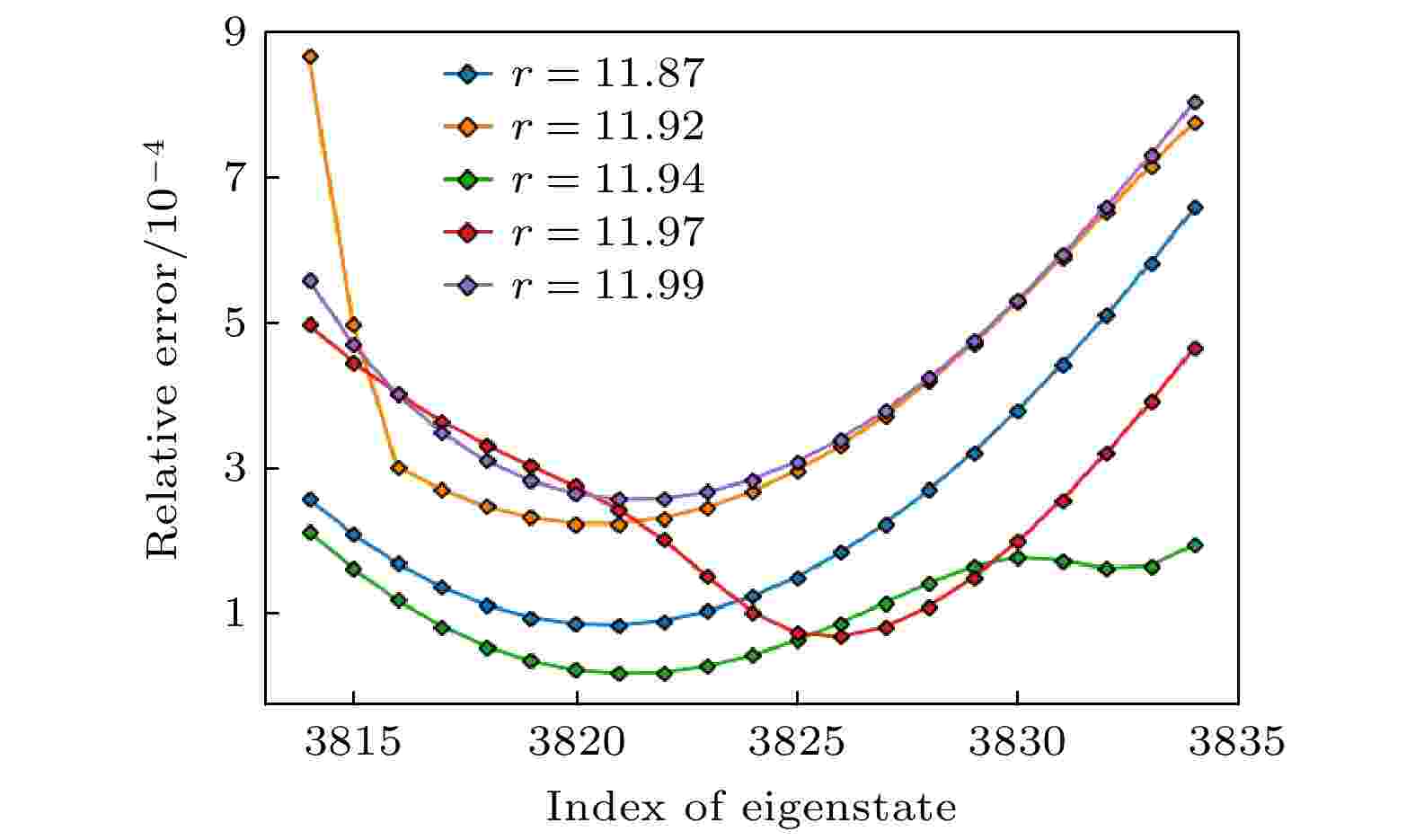
2023, 72 (18): 180302.
doi: 10.7498/aps.72.20230872
Abstract +
By combining plane waves with Gaussian or spline functions, a new composite basis set is constructed in this work. As a non local basis vector, the plane wave basis group needs a large number of plane waves to expand all parts of the physical space, including the intermediate regions that are not important to our problems. Our basis set uses the local characteristics of Gaussian function or spline function at the same time, and controls the energy interval by selecting different plane wave vectors, in order to realize the partition solution of Hamiltonian matrix. Orthogonal normalization of composite basis sets is performed by using Gram-Schmidt’s orthogonalization method or Löwdin’s orthogonalization method. Considering the completeness of plane wave vector, a certain value of positive and negative should be selected at the same time. Here, by changing the absolute value of wave vector, we can select the eigenvalue interval to be solved. The plane wave with a specific wave vector value is equivalent to a trial solution in the region with gentle potential energy. The algorithm automatically combines local Gaussian or spline functions to match the difference in wave vector value between the trial solution and the strict solution. By selecting the absolute value of the wave vector in the plane wave function, the calculation of large Hamiltonian matrices turns into the calculation of multiple small matrices, together with reducing the basis numbers in the region where the electron potential changes smoothly, therefore, we can significantly reduce the computational time. As an example, we apply this basis set to a one-dimensional finite depth potential well. It can be found that our method significantly reduce the number of basis vectors used to expand the wave function while maintaining a suitable degree of computational accuracy. We also study the influence of different parameters on calculation accuracy. Finally, the above calculation method can be directly applied to the density functional theory (DFT) calculation of plasmons in silver nanoplates or other metal nanostructures. Given a reasonable tentative initial state, the ground state electron density distribution of the system can be solved by self-consistent solution through using DFT theory, and then the electromagnetic field distribution and optical properties of the system can be solved by using time-dependent density functional theory.
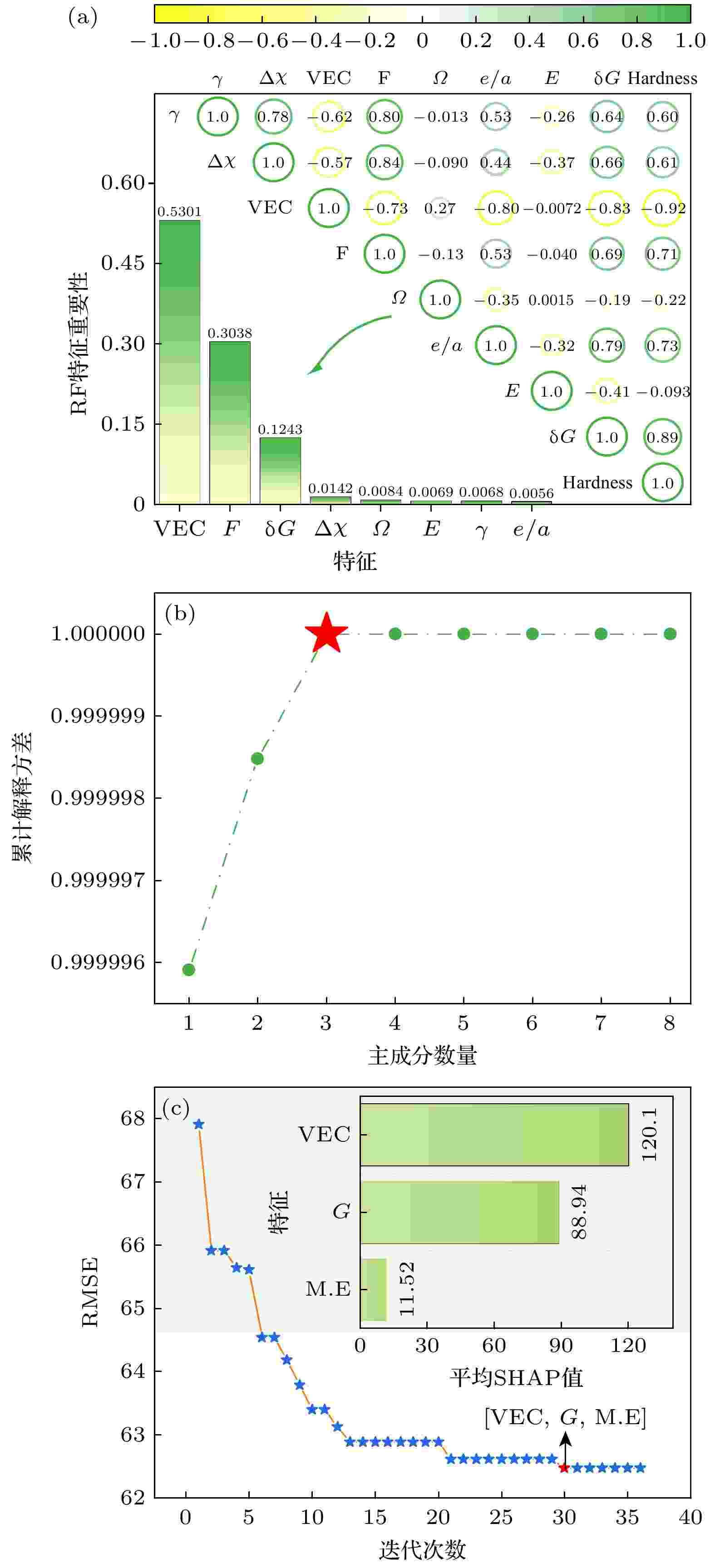
2023, 72 (18): 180701.
doi: 10.7498/aps.72.20230646
Abstract +
Traditional material calculation methods, such as first principles and thermodynamic simulations, have accelerated the discovery of new materials. However, these methods are difficult to construct models flexibly according to various target properties. And they will consume many computational resources and the accuracy of their predictions is not so high. In the last decade, data-driven machine learning techniques have gradually been applied to materials science, which has accumulated a large quantity of theoretical and experimental data. Machine learning is able to dig out the hidden information from these data and help to predict the properties of materials. The data in this work are obtained from the published references. And several performance-oriented algorithms are selected to build a prediction model for the hardness of high entropy alloys. A high entropy alloy hardness dataset containing 19 candidate features is trained, tested, and evaluated by using an ensemble learning algorithm: a genetic algorithm is selected to filter the 19 candidate features to obtain an optimized feature set of 8 features; a two-stage feature selection approach is then combined with a traditional solid solution strengthening theory to optimize the features, three most representative feature parameters are chosen and then used to build a random forest model for hardness prediction. The prediction accuracy achieves an R2 value of 0.9416 by using the 10-fold cross-validation method. To better understand the prediction mechanism, solid solution strengthening theory of the alloy is used to explain the hardness difference. Further, the atomic size, electronegativity and modulus mismatch features are found to have very important effects on the solid solution strengthening of high entropy alloys when genetic algorithms are used for implementing the feature selection. The machine learning algorithm and features are further used for predicting solid solution strengthening properties, resulting in an R2 of 0.8811 by using the 10-fold cross-validation method. These screened-out parameters have good transferability for various high entropy alloy systems. In view of the poor interpretability of the random forest algorithm, the SHAP interpretable machine learning method is used to dig out the internal reasoning logic of established machine learning model and clarify the mechanism of the influence of each feature on hardness. Especially, the valence electron concentration is found to have the most significant weakening effect on the hardness of high entropy alloys.
ELECTROMAGNETISM, OPTICS, ACOUSTICS, HEAT TRANSFER, CLASSICAL MECHANICS, AND FLUID DYNAMICS
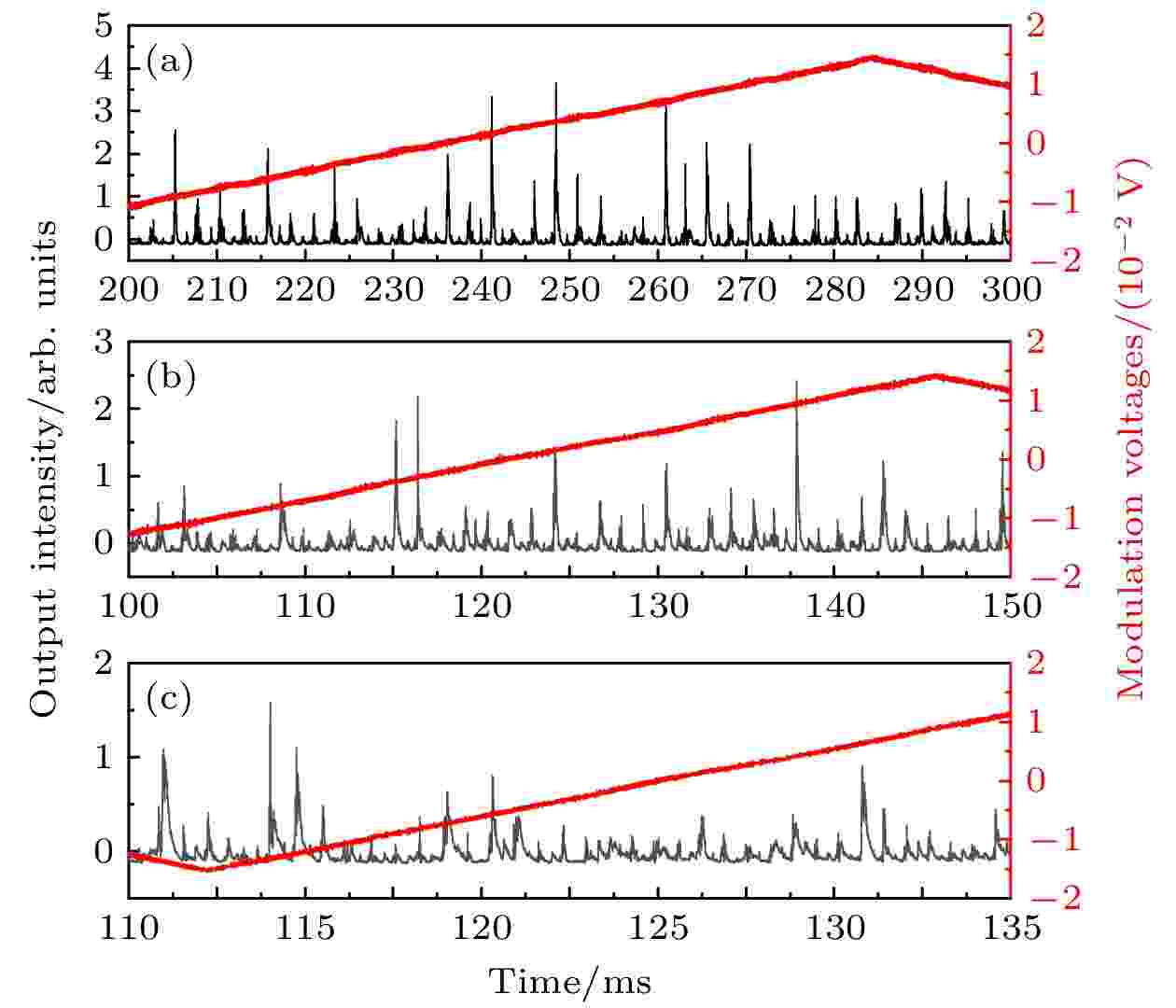
2023, 72 (18): 184205.
doi: 10.7498/aps.72.20230448
Abstract +
Using numerical simulation and a constructed cavity ring-down spectroscopy device, the influence of the finite coherence of the injected laser on the coupling process between the injected light and the cavity longitudinal mode is studied. The finite coherence of the injected light leads to the randomness of the coupling pulse during frequency scanning. The randomness is mainly reflected in two aspects. One is that as the coherence length decreases, the random amplitude range of the coupling pulse increases, and the other is that as the coherence of the injected light deteriorates, the coupling pulse changes from a single pulse with intensity evolution into continuous multiple pulses, and the overall width gradually increases with the decrease of the scanning rate. Moreover, with the deterioration of the coherence, when the light intensity of the cavity is used to turn off the injected light, the decrease in the scanning rate can cause more than one injection shut-off and ring-down event in a frequency coupling process, especially when scanning with the length of the cavity. In addition, a theoretical method is proposed to estimate the ring-down time by using the strength integral of different time intervals, and the relevant experimental verification is carried out. The experimental results show that the relative error of the ring-down time obtained by the intensity integration method is smaller than that obtained by the traditional fitting method.
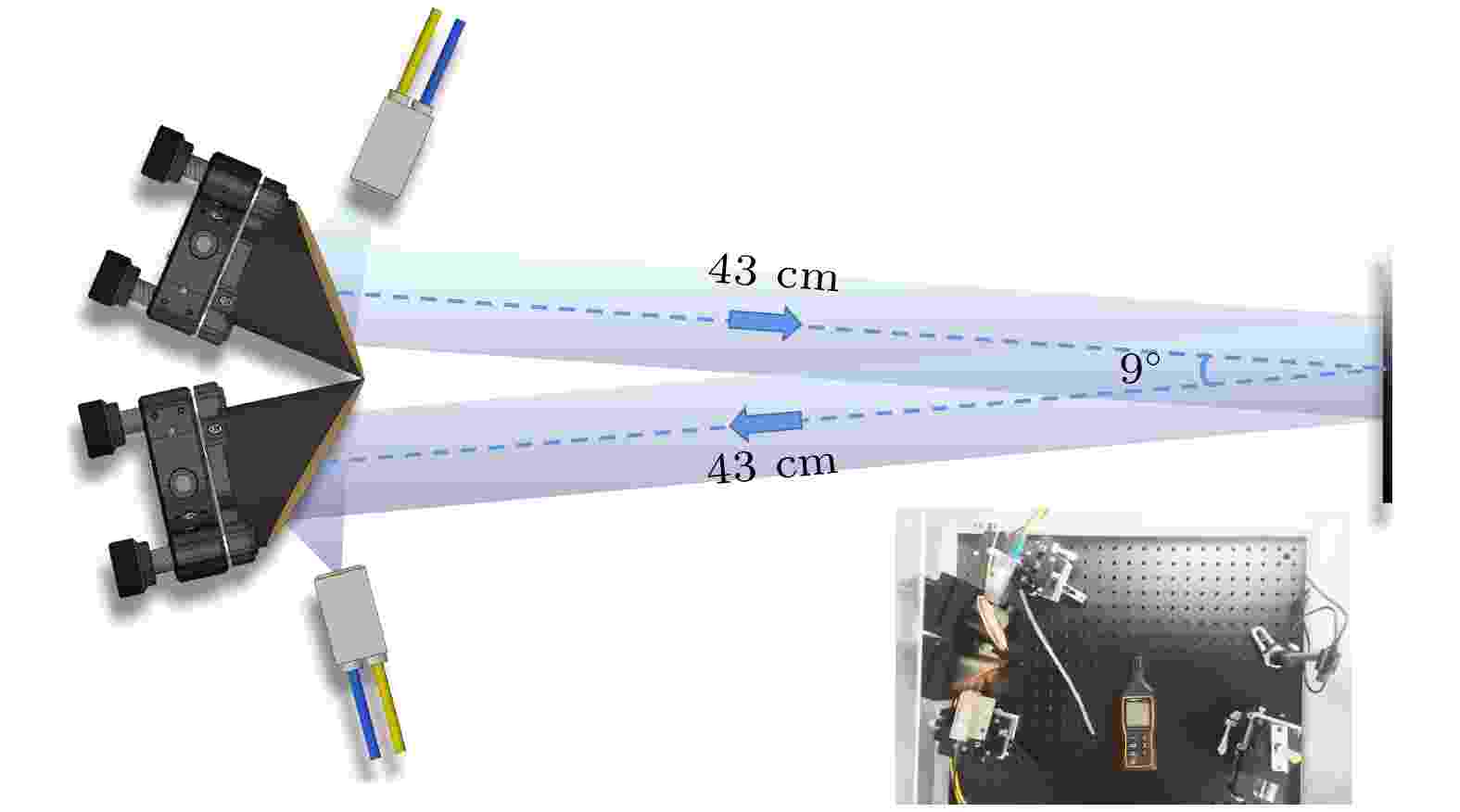
2023, 72 (18): 184101.
doi: 10.7498/aps.72.20222347
Abstract +
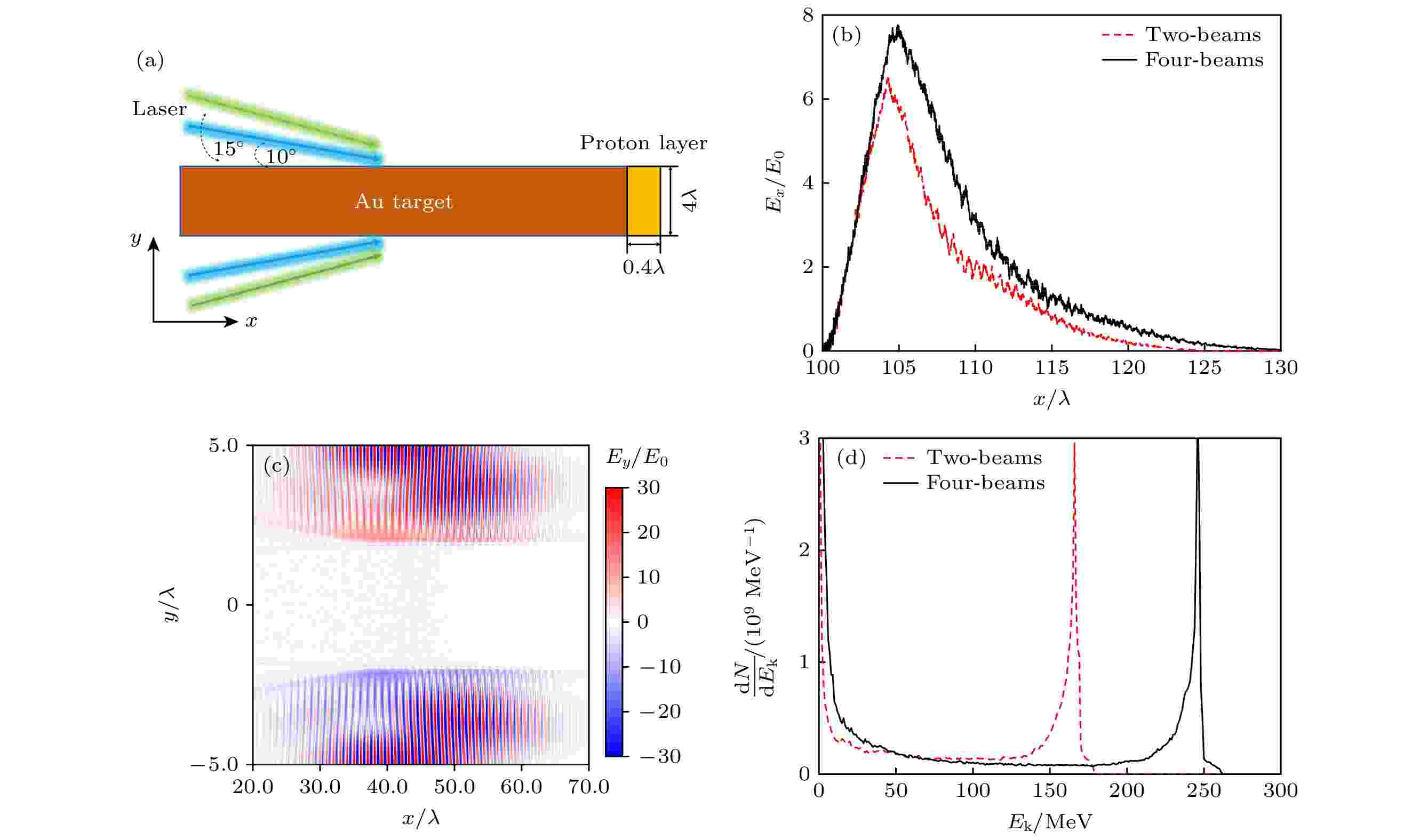
EDITOR'S SUGGESTION
2023, 72 (18): 184102.
doi: 10.7498/aps.72.20230313
Abstract +
High-energy proton beams have extensive and important applications. Traditional proton accelerators are bulky and costly. The high-power laser pulse technology provides a new proton acceleration scheme based on the interaction between laser and plasma, and has the advantage of miniaturization. Furthermore, comparing with traditional proton accelerators, the proton acceleration gradient by high-power laser pulses can be increased by three orders of magnitude. The proton beams with high brightness, narrow pulse width, and good directionality can be generated in theory within a very small effective size, and they are suitable for fields such as nuclear physics and particle physics, ion beam fast ignition, medical treatment, and proton beam detection. In order to realize laser proton acceleration, a great many of researches of different target configurations and acceleration mechanisms have been reported on proton acceleration driven by ultrashort and high-power lasers. However, owing to the limitation of laser intensity, the energy of proton beam driven by a single-beam laser is difficult to improve to meet the needs of medical applications. In this paper, a new method of driving proton acceleration by multiple ultrashort high-power lasers with grazing incidence on both sides of the microstrip target is proposed. A proton beam with an energy divergence of about 3% and energy of about 165 MeV can be obtained by using the two-beam driving setting. The results of two-dimensional particle-in-cell simulation show that a large number of collimated high-energy electron charges are extracted from both sides of the solid target by laser and injected into the back of the target. A longitudinal bunching field is established on the back of the target, which drives protons to accelerate and bunch to form a quasi-monoenergetic high-energy proton beam. The research also shows that the proton beam with an energy divergence of about 2% and energy of about 250 MeV can be obtained by using four grazing ultrashort high-power lasers on both sides of the microstrip target. The mechanism of multi-laser beams driving proton acceleration provides a new idea for the energy enhancement of the proton beam, and the quasi-monoenergetic high-energy proton beam is expected to be applied to the field of medical treatment.

2023, 72 (18): 184201.
doi: 10.7498/aps.72.20230473
Abstract +
Digital holography is one of the most widely used quantitative phase imaging technologies at present, owing to its non-contact, high-accuracy and full-filed measurement. However, when the optical path difference induced by the measurement sample is larger than the used wavelength, a phase unwrapping algorithm has to be utilized to unwrap the phase and retrieve the actual phase. And the existing phase unwrapping algorithms suffer huge computational burden and slow retrieval speed. Although they have been greatly improved, their retrieval speed is limited by the phase unwrapping. In order to solve the above-mentioned problems, a digital differentiation-integration based phase unwrapping is proposed in this paper. This algorithm is based on the fact that the actual phase information is contained in the complex-valued function after Fourier transform, band-pass filter and inverse Fourier transform. After Fourier transform, band-pass filter and inverse Fourier transform, a complex-valued function containing the actual phase is retrieved, and two sub complex-valued functions can be extracted with just one-pixel shift digitally. Then, two functions are divided pixel by pixel, and another complex-valued function containing the differentiation of the actual phase is obtained. So the differential phase can be retrieved easily by the phase extraction. Finally, the retrieved differential phase is integrated along the inverse direction of shifting, and the unwrapped phase can be obtained directly. This algorithm can work effectively when the variation of the measurement phase is in a range of (–π, π]. This algorithm is just based on the Fourier transform and the complex-valued division. Unlike the existing unwrapping algorithms, this algorithm is much easier to conduct and has light computation burden. Therefore, this algorithm can realize fast and accurate phase reconstruction directly. Several simulation and experimental results can verify the effectiveness of this algorithm.

2023, 72 (18): 184203.
doi: 10.7498/aps.72.20230657
Abstract +
Owing to the advantages of good beam quality, high conversion efficiency, convenient thermal management and compact structure, high power fiber lasers have been widely desired in industrial processing. So far, the output power has been strictly limited by the nonlinear effects and transverse mode instability. In order to break through the power limitation, here we experimentally demonstrate a power boosting technology called spectral beam combination based on dichromatic mirrors. Firstly, high power fiber amplifiers with different central wavelengths are established for the spectral combination. Secondly, utilizing a dual-beam combined system and two homemade high power fiber amplifiers, an output power of 10 kW is achieved, with a remarkable combination efficiency of 98.3% and a beam quality of M 2~1.33. Secondly, using a three-beam combined system, an output power of 13.5 kW is obtained with a combination efficiency of 96.8% and beam quality of M 2~1.61. By increasing the number of input beams and their output power as well, we believe that a higher output power can be achieved based on dichromatic mirror spectral beam combination.

2023, 72 (18): 184301.
doi: 10.7498/aps.72.20230124
Abstract +
In the shallow water waveguide, matched field tracking methods use the continuity of the peak position of the moving source and the disorder of pseudo-peaks on the sequential ambiguity surfaces to track the underwater source trajectory. However, owing to the dual influence of the space-time fluctuating shallow water waveguide environment and the complex sources motion scene, the existing matching field tracking methods are prone to track interruption, switches and false track phenomena, leading to discontinuous tracking results. Using the consistency between the peak position distance likelihood and the peak amplitude likelihood of sequential ambiguity surfaces, a continuous matched field tracking method is proposed based on the trajectory Poisson multi-Bernoulli mixture filter in this paper. The proposed method is applied to SWellEx-96 experimental data, and the tracking performance is measured by the linear programming metric. The results show that compared with the existing matching field tracking method and multi-target tracking method via random finite set, the proposed method achieves continuous tracking and accurate quantity estimation of moving sources trajectory. Among them, the prediction step and updating step in the trajectory space can avoid the phenomenon of trajectory interruption and switches in unvoiced periods.
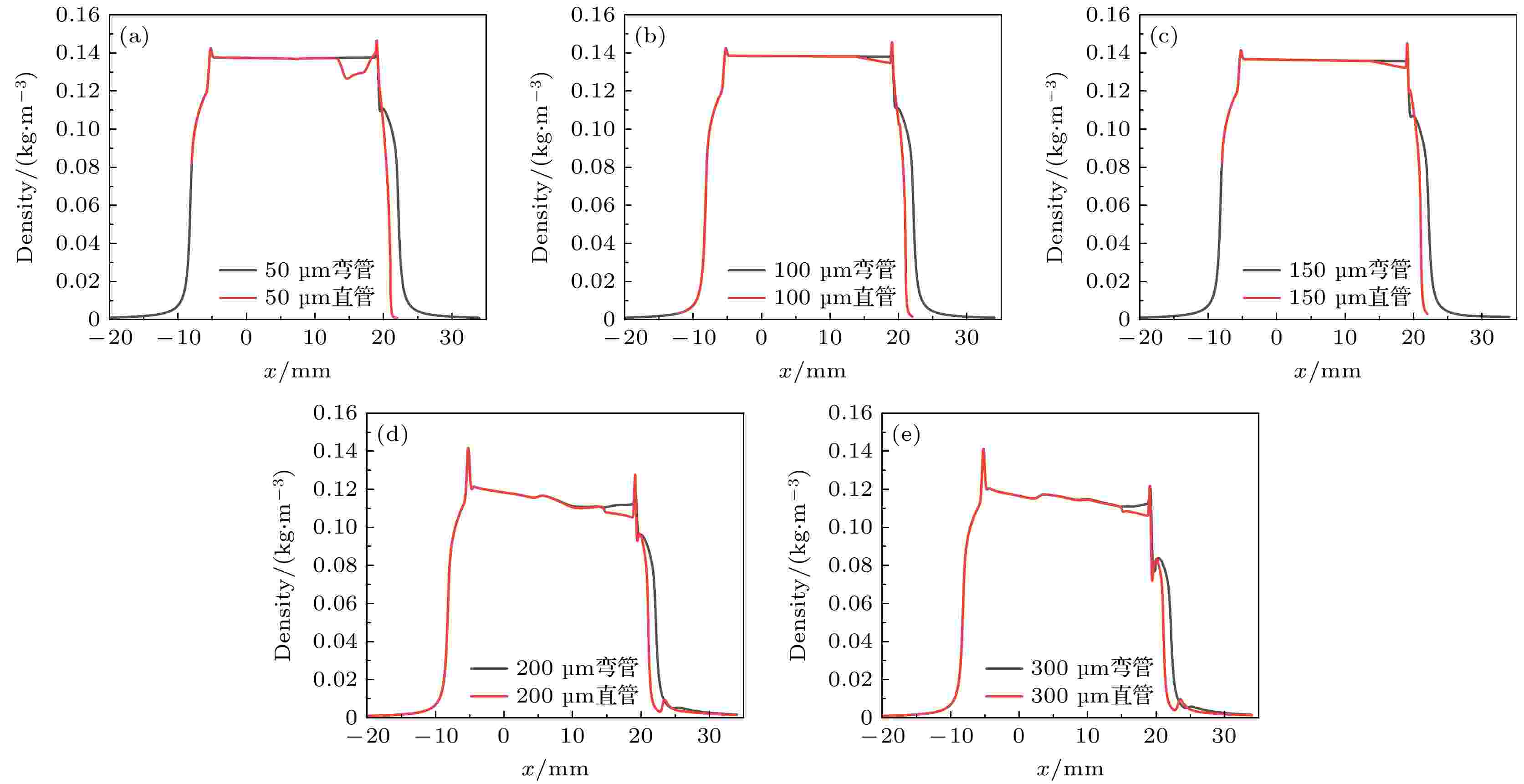
EDITOR'S SUGGESTION
2023, 72 (18): 184701.
doi: 10.7498/aps.72.20230893
Abstract +
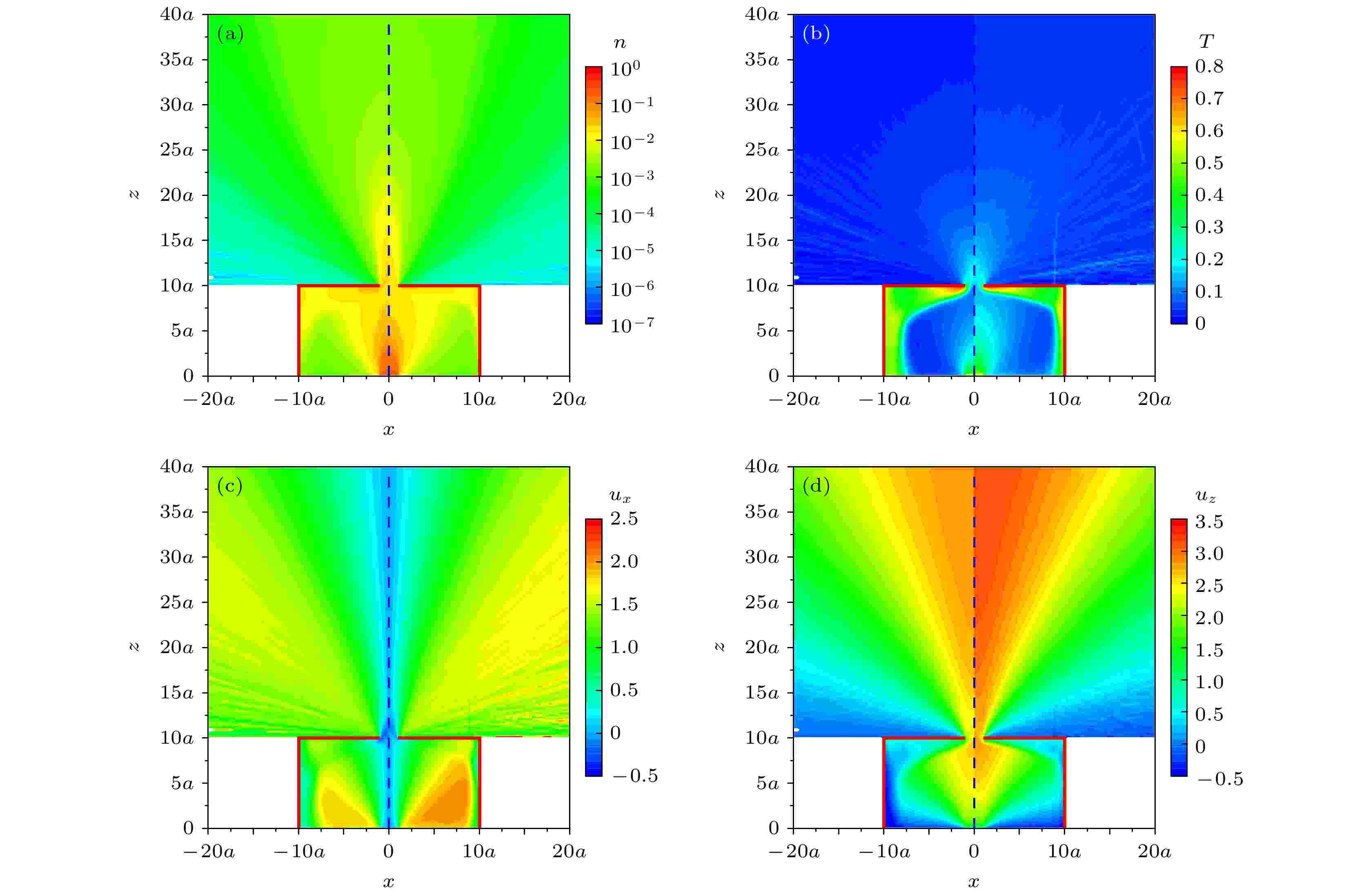
2023, 72 (18): 184702.
doi: 10.7498/aps.72.20230602
Abstract +
Lutetium-177, one of the current global research hotspots for medical isotopes, can be produced by reactor irradiation of lutetium-176, which can be produced and processed with the assistance of the electron beam physical vapor deposition (EB-PVD). The metal evaporation process is an important part of EB-PVD, which aims to convert solid metal into metal atomic vapor. The distribution of each macroscopic characteristic quantity, such as thermal population distribution, density distribution, velocity distribution, and temperature distribution of metal atomic vapor, will directly affect the utilization of metal vapor atoms, the subsequent deposition process, and coating process. In this paper, two-dimensional model and three-dimensional model of the metal evaporation process are established based on the direct simulation Monte Carlo method, and atomic metastable state is introduced into the collision assumption. The macroscopic characteristic quantities, such as the number density of metal atomic vapor, the motion velocity and the discrete degree of the total motion velocity in the evaporation process with or without considering the lutetium atomic metastable state, are analyzed and compared. The spatial distribution characteristics of each energy level of metal atomic vapor are observed, and the variation characteristics of the macroscopic characteristic quantities in the center with the slit opening size and the evaporation source surface temperature are discussed. The study results show that the number density of metal vapor passing through the beam flow device decreases, the average velocity in the x-direction and z-direction and the discrete degree of the total motion velocity increase, with the atomic metastable state taken into consideration. The beam flow device intensifies the transformation of the atomic energy level of the metal vapor and changes the physical parameters of the metal atomic vapor. At the same time, the slit opening size and the evaporation source surface temperature trigger off the change of the macroscopic characteristic quantity distribution of the metal vapor, including the degree of anomalous protrusion of each macroscopic characteristic quantity above the slit. The results of the three-dimensional simulation based on the two-dimensional model are consistent with the changes in the order of magnitude of data distribution and spatial distribution pattern, which can serve as a reference and guidance for the experimental study of the electron beam metal evaporation process.
NUCLEAR PHYSICS
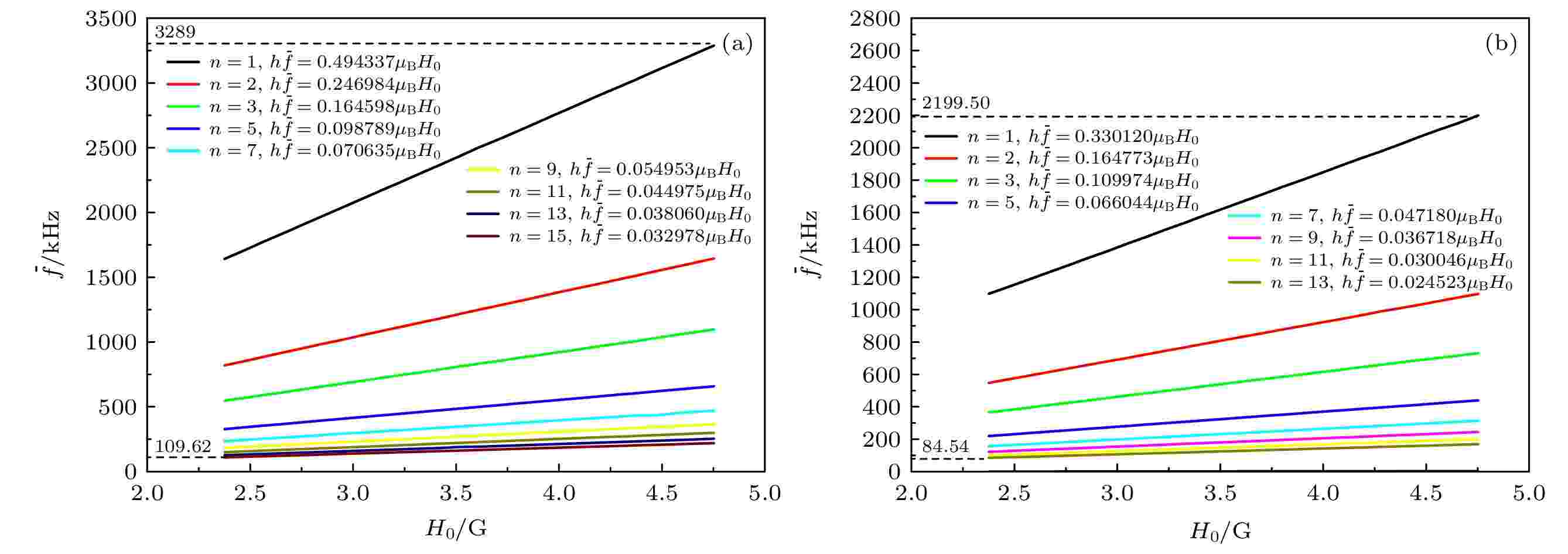
2023, 72 (18): 182101.
doi: 10.7498/aps.72.20230778
Abstract +
Because of the difficulty in measuring the cluster isotope displacement and identifying its cause, the resonance dissociation spectra, the moment shift and Zeeman energy shift of isotope cluster 87,85Rbn (n = 1, 2, 3, ··· , 13) are obtained by the combination of optical magnetic resonance and thermal dissociation techniques in this study. The quantitative calculation is carried out based on the conceptual model of the giant atom, and the results are in excellent agreement with the measured results, which shows that rubidium clusters can be analyzed as giant atoms. Furthermore, 5s electron shell level structures of the rubidium cluster 87,85Rbn (n = 1, 2, 3, ··· , 92) are calculated by using Zeeman level interval model. It is found that the main order and step distance of the 5s electron shell structure are similar to those of 3s single electron shell structure of sodium cluster in spherical symmetry. It is confirmed that the structure of the 5s electron shell of the rubidium cluster is determined by the largest energy gap in total Zeeman levels and the characteristic peaks of odd and even alternating and anomalous magnetic moments of special numbers such as n = 2 are caused by the intrinsic properties of electrons and molecular structures. It is also found that 87Rbn level shell structure and 85Rbn level shell structure strictly conform to the ratio of 3/2 magnitude relationship, and that there are abnormal differences in spectral center frequency and broadening, which may be directly related to the 85,87Rb nuclei close to the shell closure.
PHYSICS OF GASES, PLASMAS, AND ELECTRIC DISCHARGES
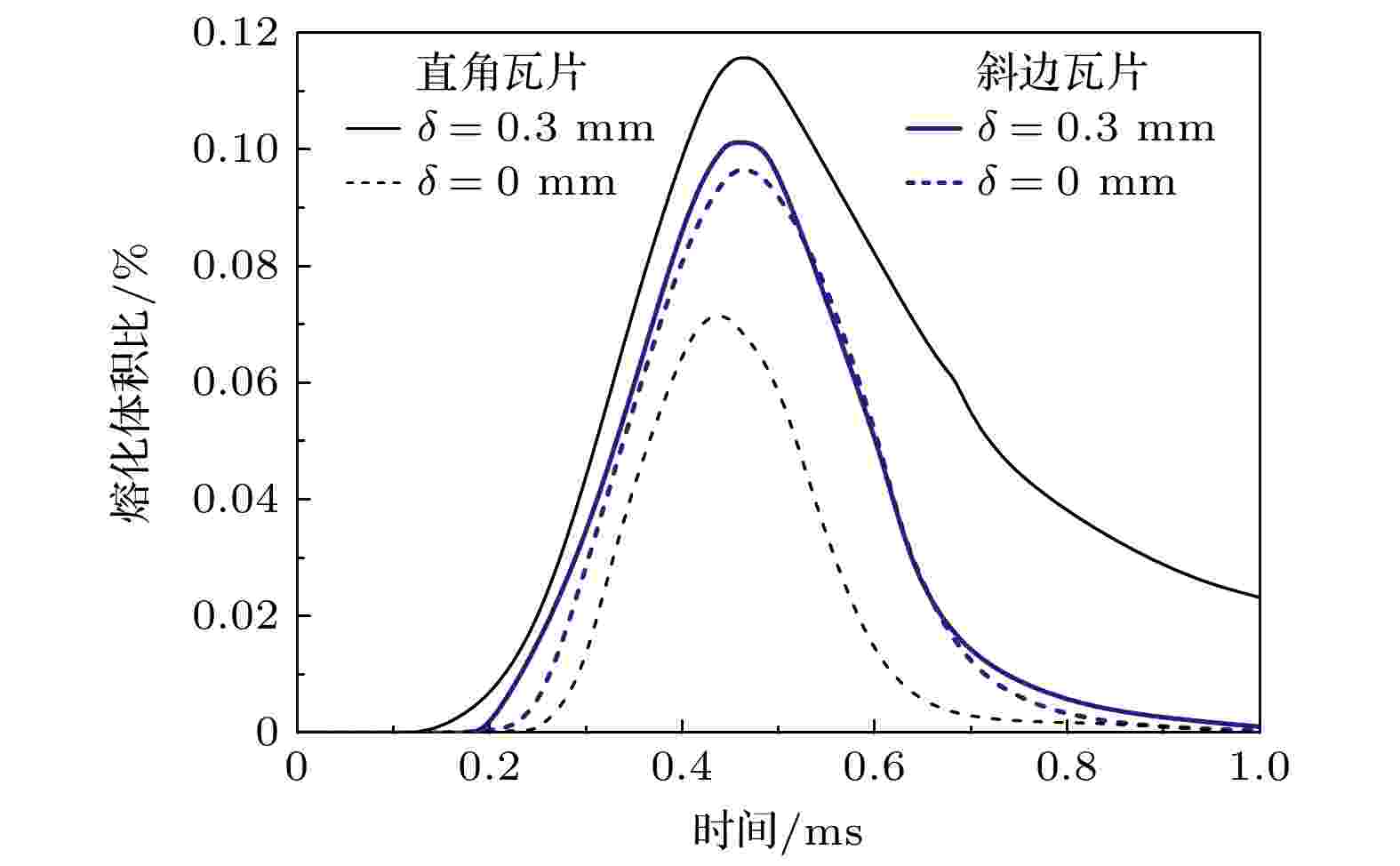
2023, 72 (18): 185202.
doi: 10.7498/aps.72.20230281
Abstract +
The thermal performance of the divertor W/Cu monoblock tiles under the ITER-like transient events has been one of the main concerns for ITER plasma facing components. Owing to the assembly tolerances during installation, the leading edge caused by misalignment between toroidal neighboring tiles will receive the extremely high cumulative heat flux and be damaged. In this work, we develop a two-dimensional heat conductivity model, including evaporation, radiation, melting process, and coupling cooling water condition, to investigate the thermal erosion of two shapes of tiles of W/Cu monoblock (unshaped and beveled tiles) with misalignment in a range from 0 to 0.3 mm, within the allowable maximum misalignment for ITER. To reflect the geometrical effects of castellated divertor tiles on the properties of its adjacent plasma, the energy flux density distribution arriving at the castellated divertor tile surface is evaluated first by using a two-dimension-in-space and three-dimension-in-velocity particle-in-cell plus Monte Carlo collisions code, and the obtained energy flux distribution is then used as input for the heat conduction model. The simulation results show that the maximum temperature of the unshaped tile with no misalignment is lower than that of the beveled tile under the steady-state inter-ELM heat flux, which increases more quickly than that of the beveled tile with misalignment increasing and will be larger than that of the beveled tile when misalignment is not less than 0.105 mm. Two shapes of the divertor tiles would melt and vaporize under typical heat flux density of a transient event of type-I edge localized modes (ELMs) for ITER, deposition energy of 1 MJ·m–2 in a duration of 600 μs. The highest temperature, the maximum melting thickness, the maximum vaporization thickness of the unshaped tile with no misalignment are higher than those of the beveled tile except the melting volume ratio. The thermal erosion of the unshaped tile increases more remarkably than that of the beveled tile with misalignment increasing, and the melting volume ratio of the unshaped tile will exceed that of the beveled tile at a misalignment of 0.17 mm. In comparison with the unshaped tile, the beveled tile is more resistant to such a high heat flux of an ELM and misalignment.
CONDENSED MATTER: STRUCTURAL, MECHANICAL, AND THERMAL PROPERTIES

2023, 72 (18): 186102.
doi: 10.7498/aps.72.20230976
Abstract +
In this paper, the displacement damage degradation characteristics of silicon carbide (SiC) Schottky barrier diode (SBD) and metal oxide semiconductor field effect transistor (MOSFET) are studied under 14-MeV neutron irradiation. The experimental results show that the neutron irradiation with a total fluence of 1.18×1011 cm–2 will not cause notable degradation of the forward I-V characteristics of the diode, but will lead to a significant increase in the reverse leakage current. A defect with energy level position of $ E_{\rm{C}} - 1.034 $ eV is observed after irradiation by deep level transient spectroscopy (DLTS) testing, which is corresponding to the neutron-induced defect cluster in SiC. This deep level defect may cause the Fermi level of n-type doping drift region to move toward the mid-gap level. It ultimately results in the decrease of the Schottky barrier and the increase of the reverse leakage current. In addition, neutron-induced gate leakage increase is also observed for SiC MOSFET. The gate current corresponding to Vgs = 15 V after irradiation increases nearly 3.3 times that before irradiation. The donor-type defects introduced by neutron irradiation in the oxide layer result in the difference in the conductivity mechanism of gate oxygen between before and after irradiation. The defects have an auxiliary effect on carrier crossing the gate oxide barrier, which leads to the increase of gate leakage current. The defects introduced by neutron irradiation are neutral after capturing electrons. The trapped electrons can cross a lower potential well and enter the conduction band to participate in conduction when the gate is positively biased, thus causing the gate current to increase with the electric field increasing. After electrons captured by donor-type defects enter the conduction band, positively charged defects are left from the gate oxide, leading to the negative shift of the transfer characteristics of SiC MOSFET. The results of DLTS testing indicate that the neutron irradiation can not only cause the intrinsic defect state of SiC material to change near the channel of MOSFET, but also give rise to new silicon vacancy defects. However, these defects are not the main cause of device performance degradation due to their low density relative to the intrinsic defect’s.

2023, 72 (18): 186301.
doi: 10.7498/aps.72.20230583
Abstract +
Inconel 718 (IN 718) is the most widely used nickel-based high-temperature alloy today. It is widely adopted in important fields such as aerospace, energy and chemicals, and is also one of the few high-temperature alloys, of which some can be fabricated by using additive manufacturing. There is a lack of research on the effect of Si on the structure and properties of IN 718 alloy on a microscopic scale. In this paper, the effect of Si doping on the γ phase in IN 718 alloy is investigated by first-principles calculations through using the CASTEP package. The lattice constants, total energy, defect formation energy, formation enthalpy, cohesive energy, density of states, and electron density difference of the γ phase are calculated before and after Si doping, and population analysis is performed. The calculation of the lattice constant reveals that the doping of Si atoms expands the cell volume of the γ phase supercell, which contributes to a certain solution strengthening effect, and is conducive to the improvement of the hardness of the alloy. The energy and electronic structure calculations show that the Si atoms prefer to occupy the Ni atomic positions in the γ phase. The number of valence electrons between the atoms, the distribution of the charge density, and the strength of the bonds between the atoms also change with Si doping, thus modifying the interaction of the atoms within the γ phase, reducing the stability of the γ phase, and favouring the precipitation of the second phase. Besides, uniform and dense IN 718 coatings with low-coat Si doping are successfully fabricated by using plasma cladding. The experimental results demonstrate that Si doping has no significant effect on the type of matrix structure of IN 718 coatings, but causes a slight expansion of the lattice of the alloy, which is consistent with the calculation result. The addition of Si can result in a transformation of the alloy coating from columnar crystal to equiaxed crystal, refining the grain size of the alloy, while reducing the volume fraction of the γ phase and increasing the volume fraction of the second phase. Moreover, the addition of Si exacerbates the segregation of Nb and Cr elements in the IN 718 coatings.
CONDENSED MATTER: ELECTRONIC STRUCTURE, ELECTRICAL, MAGNETIC, AND OPTICAL PROPERTIES
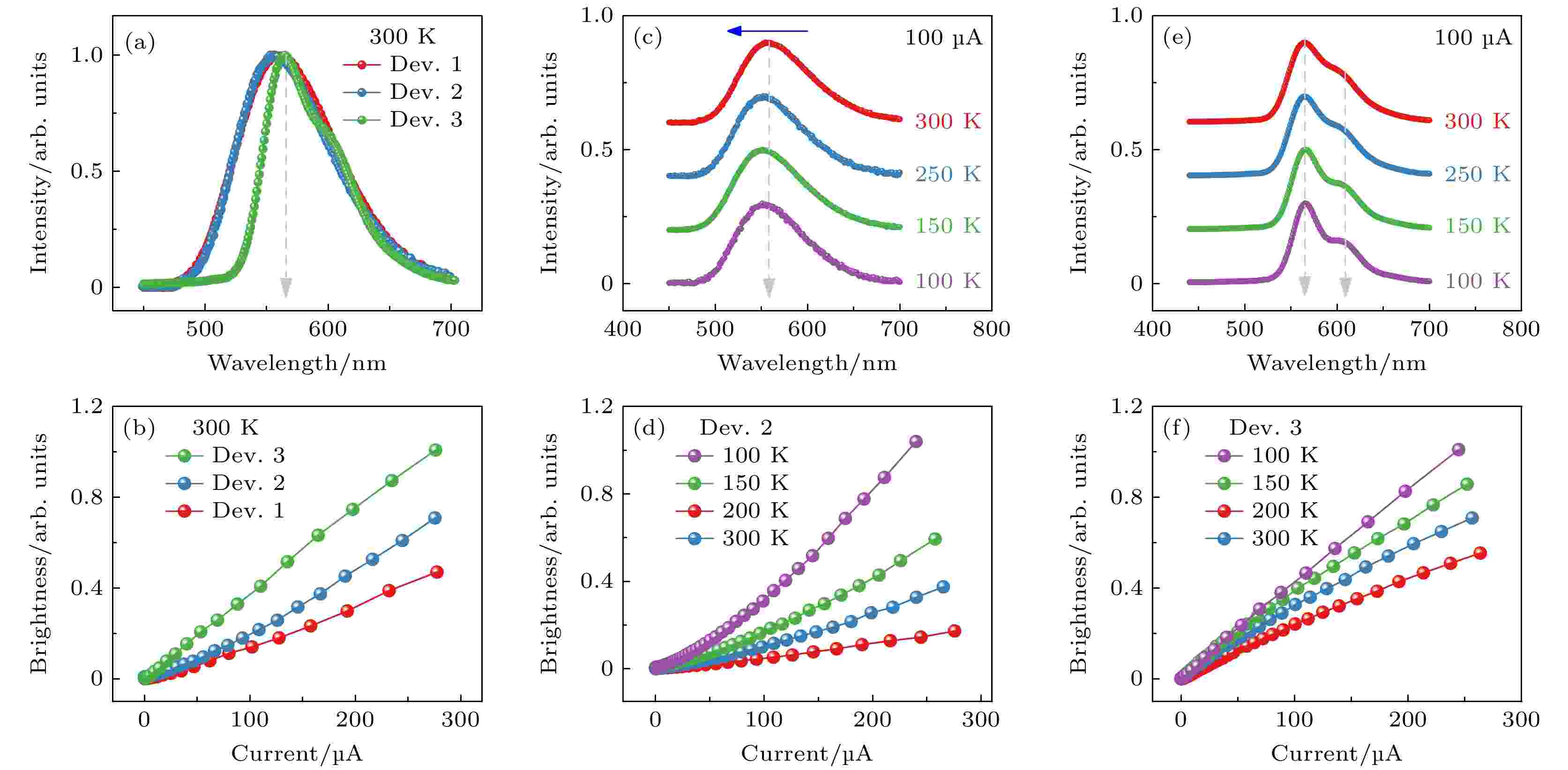
2023, 72 (18): 187201.
doi: 10.7498/aps.72.20230998
Abstract +
The maximum external quantum efficiency of the host-guest-type organic light-emitting diodes (OLEDs) with interface exciplex as the host has been over 36%. However, studies about the energy transfer processes occurring from the host to guest remain lacking. Herein, a strategy is proposed to probe the energy transfer processes in interface-type OLEDs by utilizing the characteristic magneto-electroluminescence (MEL) response from the hot exciton reverse intersystem crossing (T2,Rub → S1,Rub) of rubrene. Specifically, a donor/spacer/accepter (D/S/A)-type interface exciplex device and a D/spacer:x% Emitter/A (D/S:3% Rubrene/A)-type Rubrene-doped device are fabricated. The Förster resonance energy transfer (FRET) process occurring between the singlet state of the exciplex-host and the singlet state of Rubrene-guest is demonstrated by characterizing the photophysical properties of the donor, accepter, and guest materials. The Dexter energy transfer (DET, T1,Host → T2,Rub) process between the triplet state of the host and the triplet state of guest is visualized by the comparative studying of the current- and temperature-dependent MEL response curves of D/S/A and D/S:3% Rubrene/A devices, respectively. More importantly, the occurrence of the DET process greatly promotes the electroluminescence intensity of the D/S:3% Rubrene/A device. Furthermore, we also investigate the differences in the electroluminescence performance of devices at low temperature to demonstrate again the co-existence of FRET and DET process in the D/S:3% Rubrene/A system. Obviously, this work not only provides a promising strategy for probing the DET process in OLEDs, but also paves a new way for designing high-performance “hot exciton” type OLEDs.
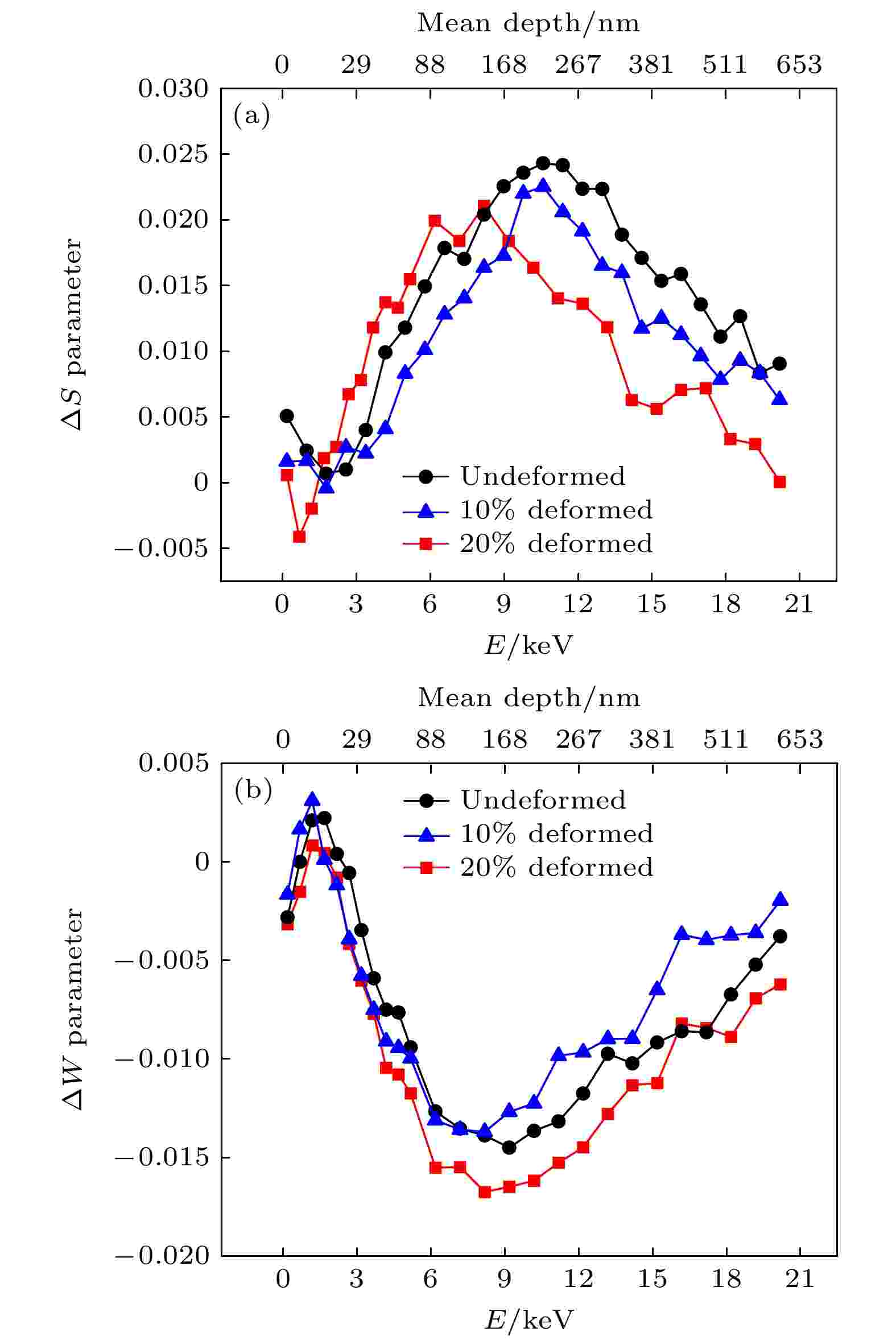
2023, 72 (18): 187801.
doi: 10.7498/aps.72.20230694
Abstract +
Reduced-activation martensitic steel is a main candidate structural material for key components of advanced nuclear energy systems because of its good mechanical properties at room temperature, low neutron activation characteristics and satisfactory radiation resistance. In this work, we study the interaction between dislocations and helium-irradiation-induced defects in the steel and the effect of dislocations on the behavior of helium migration and desorption. The well-annealed samples are pre-deformed to 10% and 20% reductions in thickness by using cold rolling mill. After pre-deformation, samples are heat-treated to remove vacancy defects and retain dislocation defects. Then, the samples with reserved dislocations are irradiated with helium at room temperature (50 keV, 1×1017 He/cm2). After irradiation, the samples are characterized by synchrotron radiation grazing incident X-Ray diffraction, positron annihilation Doppler broadening spectroscopy, and thermal desorption spectroscopy. The results show that dislocations hinder the diffusion of helium and helium-vacancy complexes, and reduce the accumulation of radiation damage. Such an effect becomes more significant with the increase of dislocation density. The BCC → FCC phase transition of low activation martensitic steel occurs at 1179 K. The increase of dislocation density will lead to the forward shift of helium desorption peak induced by phase transition. The retention of helium in the undeformed sample, 10% deformed sample and 20% deformed sample is 10.3%, 15.7% and 17.9%, respectively, indicating that high density dislocations promote the retention of helium.
INTERDISCIPLINARY PHYSICS AND RELATED AREAS OF SCIENCE AND TECHNOLOGY
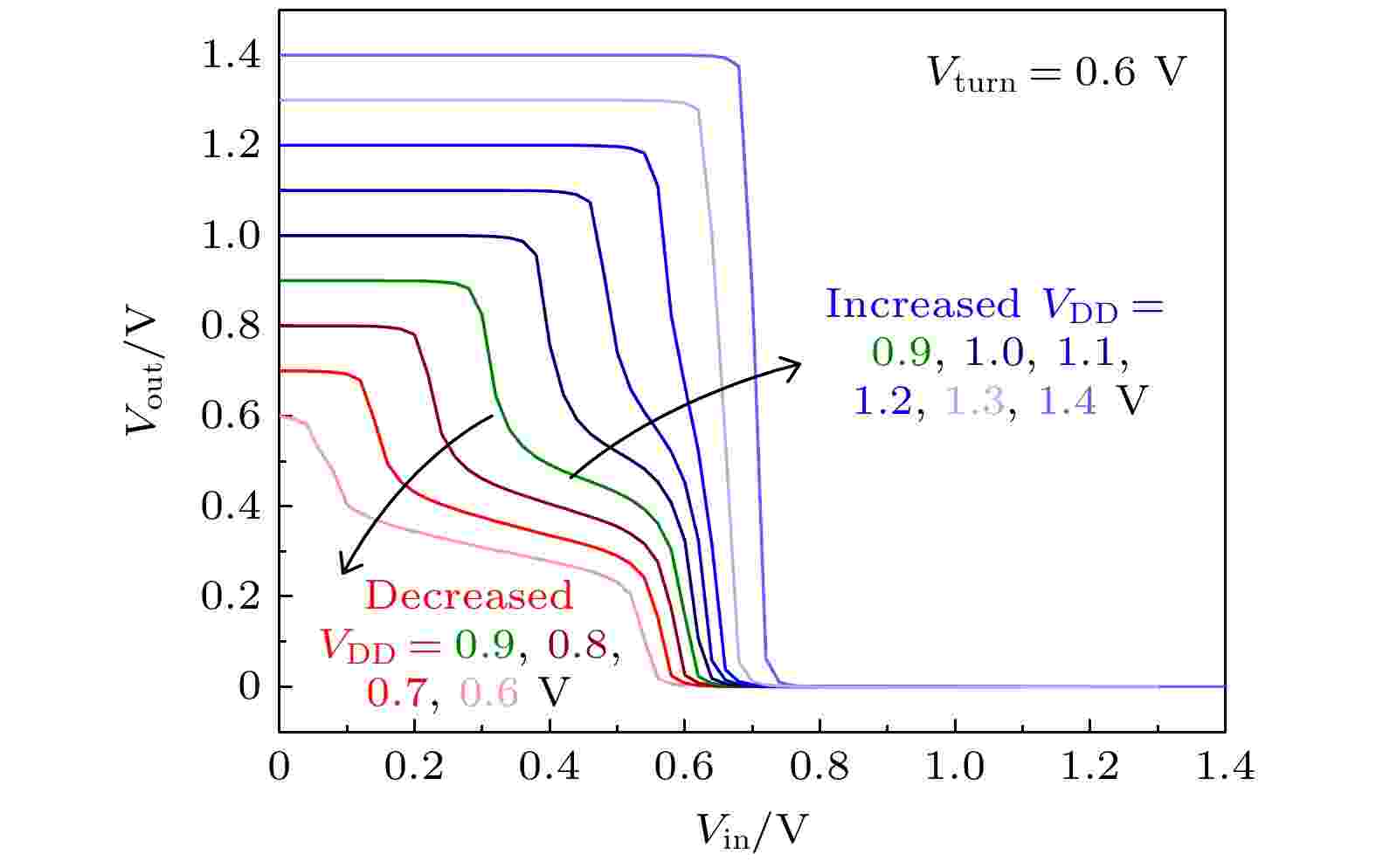
2023, 72 (18): 188501.
doi: 10.7498/aps.72.20230819
Abstract +
With the development of complementary metal-oxide semiconductor (CMOS) technology, the feature size of mental-oxide-semiconductor field-effect-transistor (MOSFET) is continuously shrunk, the short channel effect becomes more and more serious, which makes the static power consumption increase, and now the static power consumption becomes a main source of the power consumption of the integrated circuits. Currently, the performance of CMOS binary logic processor is approaching a bottleneck; therefore the ternary logic becomes a research hotspot to promote the development of high-performance low-power integrated circuits. Compared with binary logic, ternary logic possesses a strong data expression capability, which can not only improve the data density, but also reduce the circuit power consumption and the system complexity. However, using binary devices to build ternary logic circuits requires a large number of components, and even the passive components, which makes it impossible to leverage the advantages of ternary logic. The other method of implementing ternary logic is to utilize innovative two-dimensional materials. This method requires a small number of components and obviates the need for passive components, but it faces the problem that the fabrication process is not mature and cannot be mass-produced. To solve these problems, in this paper by combining the tunneling and the drift diffusion mechanism, we propose a tunneling metal-oxide-semiconductor field-effect transistor (TMOSFET) with three-state characteristics that make it highly suitable for ternary logic design. Compared with other ternary logic schemes, the ternary inverter based on TMOSFET has the same circuit structure as binary inverter, which can simplify the circuit design. In this paper, the operational mechanism of this ternary inverter is studied, and the condition of three-state output of inverter is analyzed. It is found that when the operating voltage VDD and the device turning voltage Vturn satisfy VDD/Vturn ≈ 1.4, the input voltage ranges of the three output states are equivalent. In addition, the influence of TMOSFET transfer characteristic on this ternary inverter is also analyzed. This has certain reference significance for designing and studying ternary logic circuits in future.
































